A Holocene Sedimentary Record and the Impact of Sea-Level Rise in the Karst Lake Velo Blato and the Wetlands on Pag Island (Croatia)
Abstract
1. Introduction
2. Materials and Methods
2.1. Study Site
2.2. Sampling and Side-Scan Sonar Survey
2.3. Sedimentological and Mineralogical Analysis
2.4. Geochemical Analysis
2.5. Ostracod Analysis
2.6. Radioactivity Measurements
2.7. Radiocarbon Dating
3. Results
3.1. Sedimentological and Mineralogical Description of Sediment Cores
3.2. Sediment Chronology
3.3. Grain-Size Analysis
3.4. Major and Trace Element Abundances
3.5. Total Organic Carbon and Nitrogen Concentrations
3.6. Ostracod Assemblage
3.7. Radionuclides Activities and Sedimentation Rates
4. Discussion
4.1. Paleoenvironmental Reconstructions of Lake Velo Blato and Wetlands Malo and Kolanjsko Blato
4.2. Evaluation of Metal Enrichment
5. Conclusions
Author Contributions
Funding
Institutional Review Board Statement
Informed Consent Statement
Data Availability Statement
Acknowledgments
Conflicts of Interest
References
- Last, W.M.; Smol, J.P. An Introduction to Physical and Geochemical Methods Used in Paleolimnology. In Tracking Environmental Change Using Lake Sediments; Last, W.M., Smol, J.P., Eds.; Kluwer Academic Publishers: Dordrecht, The Netherlands, 2001; pp. 1–5. [Google Scholar] [CrossRef]
- Roberts, N.; Jones, M.D.; Benkaddour, A.; Eastwood, W.J.; Filippi, M.L.; Frogley, M.R.; Lamb, H.F.; Leng, M.J.; Reed, J.M.; Stein, M.; et al. Stable Isotope Records of Late Quaternary Climate and Hydrology from Mediterranean Lakes: The ISOMED Synthesis. Quat. Sci. Rev. 2008, 27, 2426–2441. [Google Scholar] [CrossRef]
- Mayewski, P.A.; Rohling, E.E.; Stager, J.C.; Karlén, W.; Maasch, K.A.; Meeker, L.D.; Meyerson, E.A.; Gasse, F.; van Kreveld, S.; Holmgren, K.; et al. Holocene Climate Variability. Quat. Res. 2004, 62, 243–255. [Google Scholar] [CrossRef]
- Wanner, H.; Beer, J.; Bütikofer, J.; Crowley, T.J.; Cubasch, U.; Flückiger, J.; Goosse, H.; Grosjean, M.; Joos, F.; Kaplan, J.O.; et al. Mid- to Late Holocene Climate Change: An Overview. Quat. Sci. Rev. 2008, 27, 1791–1828. [Google Scholar] [CrossRef]
- Ford, D.; Williams, P. Karst Hydrogeology and Geomorphology; John Wiley & Sons Ltd.: Chichester, UK, 2007. [Google Scholar]
- Wolanski, E.; Brinson, M.; Cahoon, D.; Perillo, G. Coastal Wetlands: A Synthesis. In Coastal Wetlands: An Integrated Ecosystem Approach; Perillo, G., Wolanski, E., Cahoon, D., Brinson, M., Eds.; Elsevier Science: Amsterdam, The Netherlands, 2009; p. 64. [Google Scholar]
- Pikelj, K.; Juračić, M. Eastern Adriatic Coast (EAC): Geomorphology and Coastal Vulnerability of a Karstic Coast. J. Coast. Res. 2013, 289, 944–957. [Google Scholar] [CrossRef]
- Lambeck, K.; Antonioli, F.; Anzidei, M.; Ferranti, L.; Leoni, G.; Scicchitano, G.; Silenzi, S. Sea Level Change along the Italian Coast during the Holocene and Projections for the Future. Quat. Int. 2011, 232, 250–257. [Google Scholar] [CrossRef]
- Vacchi, M.; Marriner, N.; Morhange, C.; Spada, G.; Fontana, A.; Rovere, A. Multiproxy Assessment of Holocene Relative Sea-Level Changes in the Western Mediterranean: Sea-Level Variability and Improvements in the Definition of the Isostatic Signal. Earth Sci. Rev. 2016, 155, 172–197. [Google Scholar] [CrossRef]
- Schmidt, R.; Pugliese, N.; Müller, J.; Szeroczyriska, K.; Bogner, D.; Melis, R.; Kamenik, C.; Bari, A.; Danielopol, D.L. Palaeoclimate, Vegetation and Coastal Lake Development, from the Pleniglacial until Early Holocene, in the Northern Adriatic Valun Bay (Isle of Cres, Croatia). Quat. Ital. J. Quat. Sci. 2001, 14, 61–78. [Google Scholar]
- Avramidis, P.; Iliopoulos, G.; Panagiotaras, D.; Papoulis, D.; Lambropoulou, P.; Kontopoulos, N.; Siavalas, G.; Christanis, K. Tracking Mid- to Late Holocene Depositional Environments by Applying Sedimentological, Palaeontological and Geochemical Proxies, Amvrakikos Coastal Lagoon Sediments, Western Greece, Mediterranean Sea. Quat. Int. 2014, 332, 19–36. [Google Scholar] [CrossRef]
- Morellón, M.; Anselmetti, F.S.; Ariztegui, D.; Brushulli, B.; Sinopoli, G.; Wagner, B.; Sadori, L.; Gilli, A.; Pambuku, A. Human-Climate Interactions in the Central Mediterranean Region during the Last Millennia: The Laminated Record of Lake Butrint (Albania). Quat. Sci. Rev. 2016, 136, 134–152. [Google Scholar] [CrossRef]
- Kaniewski, D.; Marriner, N.; Morhange, C.; Rius, D.; Carre, M.-B.; Faivre, S.; Van Campo, E. Croatia’s Mid-Late Holocene (5200–3200 BP) Coastal Vegetation Shaped by Human Societies. Quat. Sci. Rev. 2018, 200, 334–350. [Google Scholar] [CrossRef]
- Brunović, D.; Miko, S.; Ilijanić, N.; Peh, Z.; Hasan, O.; Kolar, T.; Miko, M.Š.; Razum, I. Holocene Foraminiferal and Geochemical Records in the Coastal Karst Dolines of Cres Island, Croatia. Geol. Croat. 2019, 72, 19–42. [Google Scholar] [CrossRef]
- Brunović, D.; Miko, S.; Hasan, O.; Papatheodorou, G.; Ilijanić, N.; Miserocchi, S.; Correggiari, A.; Geraga, M. Late Pleistocene and Holocene Paleoenvironmental Reconstruction of a Drowned Karst Isolation Basin (Lošinj Channel, NE Adriatic Sea). Palaeogeogr. Palaeoclimatol. Palaeoecol. 2020, 544, 109587. [Google Scholar] [CrossRef]
- Razum, I.; Miko, S.; Ilijanić, N.; Hasan, O.; Šparica Miko, M.; Brunović, D.; Pawlowsky-Glahn, V. A Compositional Approach to the Reconstruction of Geochemical Processes Involved in the Evolution of Holocene Marine Flooded Coastal Karst Basins (Mljet Island, Croatia). Appl. Geochem. 2020, 116, 104574. [Google Scholar] [CrossRef]
- Razum, I.; Miko, S.; Ilijanić, N.; Petrelli, M.; Röhl, U.; Hasan, O.; Giaccio, B. Holocene Tephra Record of Lake Veliko Jezero, Croatia: Implications for the Central Mediterranean Tephrostratigraphy and Sea Level Rise. Boreas 2020, 49, 653–673. [Google Scholar] [CrossRef]
- Wunsam, S.; Schmidt, R.; Müller, J. Holocene Lake Development of Two Dalmatian Lagoons (Malo and Veliko Jezero, Isle of Mljet) in Respect to Changes in Adriatic Sea Level and Climate. Palaeogeogr. Palaeoclimatol. Palaeoecol. 1999, 146, 251–281. [Google Scholar] [CrossRef]
- Ilijanić, N. Minerali Glina u Jezerskim Sedimentima Istočno Jadranske Obale Kao Pokazatelji Promjena Okoliša Tijekom Kasnog Pleistocena i Holocena. Ph.D. Thesis, Faculty of Science, University of Zagreb, Zagreb, Croatia, 2014. [Google Scholar]
- Marriner, N.; Morhange, C.; Faivre, S.; Flaux, C.; Vacchi, M.; Miko, S.; Dumas, V.; Boetto, G.; Radic Rossi, I. Post-Roman Sea-Level Changes on Pag Island (Adriatic Sea): Dating Croatia’s “Enigmatic” Coastal Notch? Geomorphology 2014, 221, 83–94. [Google Scholar] [CrossRef]
- Rossi, I.R. Underwater Cultural Heritage and Maritime Archaeology in Croatia: An Overview. Eur. J. Archaeol. 2012, 15, 285–308. [Google Scholar] [CrossRef]
- Jerbić, K. Zambratija: A 6000-Year-Old Pile-Dwelling Submerged under the Adriatic Sea. Ph.D. Thesis, Flinders University, Bedford Park, Australia, 2020. [Google Scholar]
- Bakrač, K.; Ilijanić, N.; Miko, S.; Hasan, O. Evidence of Sapropel S1 Formation from Holocene Lacustrine Sequences in Lake Vrana in Dalmatia (Croatia). Quat. Int. 2018, 494, 5–18. [Google Scholar] [CrossRef]
- Galović, I.; Caput Mihalić, K.; Ilijanić, N.; Miko, S.; Hasan, O. Diatom Responses to Holocene Environmental Changes in a Karstic Lake Vrana in Dalmatia (Croatia). Quat. Int. 2018, 494, 167–179. [Google Scholar] [CrossRef]
- Hajek-Tadesse, V.; Ilijanić, N.; Miko, S.; Hasan, O. Holocene Ostracoda (Crustacea) from the Shallow Lake Vrana (Dalmatia, Croatia) and Their Paleoenvironmental Significanc. Quat. Int. 2018, 494, 80–91. [Google Scholar] [CrossRef]
- Ilijanić, N.; Miko, S.; Hasan, O.; Bakrač, K. Holocene Environmental Record from Lake Sediments in the Bokanjačko Blato Karst Polje (Dalmatia, Croatia). Quat. Int. 2018, 494, 66–79. [Google Scholar] [CrossRef]
- Razum, I.; Bajo, P.; Brunović, D.; Ilijanić, N.; Hasan, O.; Röhl, U.; Miko, M.Š.; Miko, S. Past Climate Variations Recorded in Needle-like Aragonites Correlate with Organic Carbon Burial Efficiency as Revealed by Lake Sediments in Croatia. Sci. Rep. 2021, 11, 7568. [Google Scholar] [CrossRef] [PubMed]
- Magny, M.; Peyron, O.; Sadori, L.; Ortu, E.; Zanchetta, G.; Vannière, B.; Tinner, W. Contrasting Patterns of Precipitation Seasonality during the Holocene in the South- and North-Central Mediterranean. J. Quat. Sci. 2012, 27, 290–296. [Google Scholar] [CrossRef]
- Magny, M.; Combourieu-Nebout, N.; de Beaulieu, J.L.; Bout-Roumazeilles, V.; Colombaroli, D.; Desprat, S.; Francke, A.; Joannin, S.; Ortu, E.; Peyron, O.; et al. North–South Palaeohydrological Contrasts in the Central Mediterranean during the Holocene: Tentative Synthesis and Working Hypotheses. Clim. Past 2013, 9, 2043–2071. [Google Scholar] [CrossRef]
- Peyron, O.; Magny, M.; Goring, S.; Joannin, S.; de Beaulieu, J.-L.; Brugiapaglia, E.; Sadori, L.; Garfi, G.; Kouli, K.; Ioakim, C.; et al. Contrasting Patterns of Climatic Changes during the Holocene across the Italian Peninsula Reconstructed from Pollen Data. Clim. Past 2013, 9, 1233–1252. [Google Scholar] [CrossRef]
- Finné, M.; Woodbridge, J.; Labuhn, I.; Roberts, C.N. Holocene Hydro-Climatic Variability in the Mediterranean: A Synthetic Multi-Proxy Reconstruction. Holocene 2019, 29, 847–863. [Google Scholar] [CrossRef]
- Seguin, J.; Avramidis, P.; Haug, A.; Kessler, T.; Schimmelmann, A.; Unkel, I. Reconstruction of Palaeoenvironmental Variability Based on an Inter- Comparison of Four Lacustrine Archives on the Peloponnese (Greece) for the Last 5000 Years. EG Quat. Sci. J. 2020, 69, 165–186. [Google Scholar] [CrossRef]
- Roberts, N.; Eastwood, W.J.; Kuzucuoğlu, C.; Fiorentino, G.; Caracuta, V. Climatic, Vegetation and Cultural Change in the Eastern Mediterranean during the Mid-Holocene Environmental Transition. Holocene 2011, 21, 147–162. [Google Scholar] [CrossRef]
- Piva, A.; Asioli, A.; Trincardi, F.; Schneider, R.R.; Vigliotti, L. Late-Holocene Climate Variability in the Adriatic Sea (Central Mediterranean). Holocene 2008, 18, 153–167. [Google Scholar] [CrossRef]
- Combourieu-Nebout, N.; Peyron, O.; Bout-Roumazeilles, V.; Goring, S.; Dormoy, I.; Joannin, S.; Sadori, L.; Siani, G.; Magny, M. Holocene Vegetation and Climate Changes in the Central Mediterranean Inferred from a High-Resolution Marine Pollen Record (Adriatic Sea). Clim. Past 2013, 9, 2023–2042. [Google Scholar] [CrossRef]
- Schmidt, R.; Müller, J.; Drescher-Schneider, R.; Krisai, R.; Szeroczyńska, K.; Barić, A. Changes in Lake Level and Trophy at Lake Vrana, a Large Karstic Lake on the Island of Cres (Croatia), with Respect to Palaeoclimate and Anthropogenic Impacts during the Last Approx. 16,000 Years. J. Limnol. 2000, 59, 113. [Google Scholar] [CrossRef]
- Kaniewski, D.; Marriner, N.; Morhange, C.; Faivre, S.; Otto, T.; Van Campo, E. Solar Pacing of Storm Surges, Coastal Flooding and Agricultural Losses in the Central Mediterranean. Sci. Rep. 2016, 6, 25197. [Google Scholar] [CrossRef]
- Siani, G.; Magny, M.; Paterne, M.; Debret, M.; Fontugne, M. Paleohydrology Reconstruction and Holocene Climate Variability in the South Adriatic Sea. Clim. Past 2013, 9, 499–515. [Google Scholar] [CrossRef]
- Rudzka, D.; Mcdermott, F.; Surić, M. A Late Holocene Climate Record in Stalagmites from Modrič Cave (Croatia). J. Quat. Sci. 2012, 27, 585–596. [Google Scholar] [CrossRef]
- Surić, M.; Bajo, P.; Lončarić, R.; Lončar, N.; Drysdale, R.N.; Hellstrom, J.C.; Hua, Q. Speleothem Records of the Hydroclimate Variability throughout the Last Glacial Cycle from Manita Peć Cave (Velebit Mountain, Croatia). Geosciences 2021, 11, 347. [Google Scholar] [CrossRef]
- Lončar, N.; Bar-Matthews, M.; Ayalon, A.; Faivre, S.; Surić, M. Holocene Climatic Conditions in the Eastern Adriatic Recorded in Stalagmites from Strašna Peć Cave (Croatia). Quat. Int. 2019, 508, 98–106. [Google Scholar] [CrossRef]
- Lončar, N.; Bar-Matthews, M.; Avalon, A.; Surić, M.; Faivre, S. Early and Mid-Holocene Environmental Conditions in the Eastern Adriatic Recorded in Speleotherms from Mala Špilja Cave and Velika Špilja Cave (Mljet Island, Croatia). Acta Carsologica 2017, 46, 229–249. [Google Scholar] [CrossRef]
- Surić, M.; Columbu, A.; Lončarić, R.; Bajo, P.; Bočić, N.; Lončar, N.; Drysdale, R.N.; Hellstrom, J.C. Holocene Hydroclimate Changes in Continental Croatia Recorded in Speleothem δ 13 C and δ 18 O from Nova Grgosova Cave. Holocene 2021, 31, 1401–1416. [Google Scholar] [CrossRef]
- Hasan, O. Paleookolišna Rekonstrukcija Slivova Karinskoga Mora, Novigradskoga Mora i Velebitskog Kanala Tijekom Holocena. Ph.D. Thesis, Faculty of Mining, Geology and Petroleum Engineering, University of Zagreb, Zagreb, Croatia, 2017. [Google Scholar]
- Hasan, O.; Miko, S.; Brunović, D.; Papatheodorou, G.; Christodolou, D.; Ilijanić, N.; Geraga, M. Geomorphology of Canyon Outlets in Zrmanja River Estuary and Its Effect on the Holocene Flooding of Semi-Enclosed Basins (the Novigrad and Karin Seas, Eastern Adriatic). Water 2020, 12, 2807. [Google Scholar] [CrossRef]
- Faivre, S.; Fouache, E.; Ghilardi, M.; Antonioli, F.; Furlani, S.; Kovačić, V. Relative Sea Level Change in Western Istria (Croatia) during the Last Millennium. Quat. Int. 2011, 232, 132–143. [Google Scholar] [CrossRef]
- Felja, I.; Fontana, A.; Furlani, S.; Bajraktarević, Z.; Paradžik, A.; Topalović, E.; Rossato, S.; Ćosović, V.; Juračić, M. Environmental Changes in the Lower Mirna River Valley (Istria, Croatia) during Upper Holocene. Geol. Croat. 2015, 68, 209–224. [Google Scholar] [CrossRef]
- Surić, M.; Juračić, M. Late Pleistocene—Holocene Environmental Changes—Records from Submerged Speleothems along the Eastern Adriatic Coast (Croatia). Geol. Croat. 2010, 63, 155–169. [Google Scholar] [CrossRef]
- Surić, M.; Juračić, M.; Horvatinčić, N.; Krajcar Bronić, I. Late Pleistocene–Holocene Sea-Level Rise and the Pattern of Coastal Karst Inundation: Records from Submerged Speleothems along the Eastern Adriatic Coast (Croatia). Mar. Geol. 2005, 214, 163–175. [Google Scholar] [CrossRef]
- Bechor, B.; Sivan, D.; Miko, S.; Hasan, O.; Grisonic, M.; Rossi, I.R.; Lorentzen, B.; Artioli, G.; Ricci, G.; Ivelja, T.; et al. Salt Pans as a New Archaeological Sea-Level Proxy: A Test Case from Dalmatia, Croatia. Quat. Sci. Rev. 2020, 250, 106680. [Google Scholar] [CrossRef]
- Florido, E.; Auriemma, R.; Faivre, S.; Radić Rossi, I.; Antonioli, F.; Furlani, S.; Spada, G. Istrian and Dalmatian Fishtanks as Sea-Level Markers. Quat. Int. 2011, 232, 105–113. [Google Scholar] [CrossRef]
- Ivelja, T.; Bechor, B.; Hasan, O.; Miko, S.; Sivan, D.; Brook, A. Improving Vertical Accuracy of Uav Digital Surface Models by Introducing Terrestrial Laser Scans on a Point-Cloud Level. Int. Arch. Photogramm. Remote Sens. Spat. Inf. Sci 2020, XLIII-B1-2, 457–463. [Google Scholar] [CrossRef]
- Faivre, S.; Bakran-Petricioli, T.; Horvatinčić, N.; Sironić, A. Distinct Phases of Relative Sea Level Changes in the Central Adriatic during the Last 1500 years—Influence of Climatic Variations? Palaeogeogr. Palaeoclimatol. Palaeoecol. 2013, 369, 163–174. [Google Scholar] [CrossRef]
- Faivre, S.; Bakran-Petricioli, T.; Barešić, J.; Horvatić, D.; Macario, K. Relative Sea-Level Change and Climate Change in the Northeastern Adriatic during the Last 1.5 Ka (Istria, Croatia). Quat. Sci. Rev. 2019, 222, 105909. [Google Scholar] [CrossRef]
- Fouache, E.; Faivre, S.; Gluščević, S.; Kovačić, V.; Tassaux, F.; Dufaure, J.J. Evolution of the Croatian Shore Line between Poreč and Split over the Past 2000 Years. Archaelogia Marit. Mediterr. 2005, 2, 116–134. [Google Scholar]
- Prohić, E.; Kniewald, G. Heavy Metal Distribution in Recent Sediments of the Krka River Estuary—An Example of Sequential Extraction Analysis. Mar. Chem. 1987, 22, 279–297. [Google Scholar] [CrossRef]
- Bogner, D.; Juracic, M.; Odžak, N.; Baric, A. Trace Metals in Fine Grained Sediments of the Kaštela Bay, Adriatic Sea. Water Sci. Technol. 1998, 38, 169–175. [Google Scholar] [CrossRef]
- Šparica, M.; Koch, G.; Belak, M.; Miko, S.; Šparica Miko, M.; Viličić, D.; Dolenec, T.; Bergant, S.; Lojen, S.; Vreča, P.; et al. Recent Sediments of Makirina Bay (Northern Dalmatia, Croatia): Their Origin Viewed through a Multidisciplinary Approach. Geol. Croat. 2005, 58, 21–71. [Google Scholar]
- Miko, S.; Koch, G.; Mesić, S.; Šparica Miko, M.; Šparica, M.; Vreča, P.; Dolenec, T. Influence of Land Use in Small Karst Watersheds on the Chemical Status of Peloid Sediments on the Eastern Adriatic Coast. J. Soils Sediments 2007, 7, 303–312. [Google Scholar] [CrossRef]
- Sondi, I.; Lojen, S.; Juračić, M.; Prohić, E. Mechanisms of Land–Sea Interactions—The Distribution of Metals and Sedimentary Organic Matter in Sediments of a River-Dominated Mediterranean Karstic Estuary. Estuar. Coast. Shelf Sci. 2008, 80, 12–20. [Google Scholar] [CrossRef]
- Cuculić, V.; Cukrov, N.; Kwokal, Ž.; Mlakar, M. Natural and Anthropogenic Sources of Hg, Cd, Pb, Cu and Zn in Seawater and Sediment of Mljet National Park, Croatia. Estuar. Coast. Shelf Sci. 2009, 81, 311–320. [Google Scholar] [CrossRef]
- Cukrov, N.; Frančišković-Bilinski, S.; Hlača, B.; Barišić, D. A Recent History of Metal Accumulation in the Sediments of Rijeka Harbor, Adriatic Sea, Croatia. Mar. Pollut. Bull. 2011, 62, 154–167. [Google Scholar] [CrossRef] [PubMed]
- Obhođaš, J.; Valković, V.; Matjačić, L.; Nađ, K.; Sudac, D. Evaluation of Elemental Composition of Sediments from the Adriatic Sea by Using EDXRF Technique. Appl. Radiat. Isot. 2012, 70, 1392–1395. [Google Scholar] [CrossRef]
- Lovrenčić Mikelić, I.; Oreščanin, V.; Barišić, D. Distribution and Origin of Major, Minor, and Trace Elements in Sediments and Sedimentary Rocks of the Kaštela Bay (Croatia) Coastal Area. J. Geochem. Explor. 2013, 128, 1–13. [Google Scholar] [CrossRef]
- Ivanić, M.; Lojen, S.; Grozić, D.; Jurina, I.; Škapin, S.D.; Troskot-Čorbić, T.; Mikac, N.; Juračić, M.; Sondi, I. Geochemistry of Sedimentary Organic Matter and Trace Elements in Modern Lake Sediments from Transitional Karstic Land-Sea Environment of the Neretva River Delta (Kuti Lake, Croatia). Quat. Int. 2018, 494, 286–299. [Google Scholar] [CrossRef]
- Cukrov, N.; Doumandji, N.; Garnier, C.; Tucaković, I.; Dang, D.H.; Omanović, D.; Cukrov, N. Anthropogenic Mercury Contamination in Sediments of Krka River Estuary (Croatia). Environ. Sci. Pollut. Res. 2020, 27, 7628–7638. [Google Scholar] [CrossRef]
- Dolenec, T.; Faganeli, J.; Pirc, S. Major, Minor and Trace Elements in Surficial Sediments from the Open Adriatic Sea: A Regional Geochemical Study. Geol. Croat. 1998, 51, 59–73. [Google Scholar]
- De Lazzari, A.; Rampazzo, G.; Pavoni, B. Geochemistry of Sediments in the Northern and Central Adriatic Sea. Estuar. Coast. Shelf Sci. 2004, 59, 429–440. [Google Scholar] [CrossRef]
- Spagnoli, F.; Dell’Anno, A.; De Marco, A.; Dinelli, E.; Fabiano, M.; Gadaleta, M.V.; Ianni, C.; Loiacono, F.; Manini, E.; Marini, M.; et al. Biogeochemistry, Grain Size and Mineralogy of the Central and Southern Adriatic Sea Sediments: A Review. Chem. Ecol. 2010, 26, 19–44. [Google Scholar] [CrossRef]
- Calanchi, N.; Dinelli, E.; Lucchini, F.; Mordenti, A. Chemostratigraphy of Late Quaternary Sediments from Lake Albano and Central Adriatic Sea Cores (PALICLAS Project). Mem. dell’Istituto Ital. Idrobiol. 1996, 55, 247–263. [Google Scholar]
- Kelletat, D.H. Dalmatian Coasts. In Encyclopedia of Coastal Science; Schwartz, M., Ed.; Springer: Dordrecht, The Netherlands, 2005; pp. 355–356. [Google Scholar] [CrossRef]
- Leder, T.D.; Ujević, T.; Čala, M. Coastline Lenghts and Areas of Islands in the Croatian Part of the Adriatic Sea Determined from the Topographic Maps at the Scale of 1:25,000. Geoadria 2017, 9, 5–32. [Google Scholar] [CrossRef]
- Vlahović, I.; Tišljar, J.; Velić, I.; Matičec, D. Evolution of the Adriatic Carbonate Platform: Palaeogeography, Main Events and Depositional Dynamics. Palaeogeogr. Palaeoclimatol. Palaeoecol. 2005, 220, 333–360. [Google Scholar]
- Mamužić, P.; Sokač, B.; Velić, I. Osnovna Geološka Karta SFRJ 1:100,000, List Silba; Institut za Geološka Istraživanja: Zagreb, Croatia, 1970. [Google Scholar]
- Mamužić, P.; Sokač, B. Osnovna Geološka Karta SFRJ 1:100,000. Tumač Za Listove Molat i Silba; Institut za Geološka Istraživanja: Zagreb, Croatia, 1973; p. 45. [Google Scholar]
- Sokač, B.; Nikler, I.; Velić, I.; Mamužić, P. Osnovna Geološka Karta SFRJ, 1:100,000, List Gospić; Institut za Geološka Istraživanja: Zagreb, Croatia, 1974. [Google Scholar]
- Sokač, B.; Ščavničar, B.; Velić, I. Osnovna Geološka Karta SFRJ, 1:100,000. Tumač Za List Gospić; Institut za Geološka Istraživanja: Zagreb, Croatia, 1976; p. 64. [Google Scholar]
- Bulić, J.; Jurišić-Polšak, Z. Macropalaeontology and Stratigraphy of Lacustrine Miocene Deposits at Crnika Beach on the Island of Pag (Croatia). Geol. Croat. 2009, 62, 135–156. [Google Scholar] [CrossRef]
- Jiménez-Moreno, G.; de Leeuw, A.; Mandic, O.; Harzhauser, M.; Pavelić, D.; Krijgsman, W.; Vranjković, A. Integrated Stratigraphy of the Early Miocene Lacustrine Deposits of Pag Island (SW Croatia): Palaeovegetation and Environmental Changes in the Dinaride Lake System. Palaeogeogr. Palaeoclimatol. Palaeoecol. 2009, 280, 193–206. [Google Scholar] [CrossRef]
- Magdalenić, A. Hidrogeologija Otoka Paga. Krš Jugosl. 1984, 10–16, 119–137. [Google Scholar]
- Lukač Reberski, J.; Terzić, J.; Dolić, S. Hydrogeological and Hydrochemical Features of the Island of Pag. In Proceedings of the 4th Croatian Geological Congress, Zagreb, Croatia, 14–15 October 2010; pp. 209–210. [Google Scholar]
- Ljubešić, J.; Munda, B. Elaborat Zona Sanitarne Zaštite Vodocrpilište Velo blato—Otok Pag; Documentation fund Croatian Waters: Zagreb, Croatia, 2015. [Google Scholar]
- Faričić, J. Pag Island on Old Cartographic Presentations. Geoadria 2003, 8, 47–126. (In Croatian) [Google Scholar] [CrossRef][Green Version]
- Sinergise Ltd. EO Browser. Available online: https://apps.sentinel-hub.com/eo-browser/ (accessed on 8 August 2021).
- Lončar, N. Geomorphologic Regionalization of the Central and Southern Parts of Pag Island. Geoadria 2009, 14, 5–25. [Google Scholar] [CrossRef]
- Mitić, B.; Topić, J.; Ilijanić, L.; Jasprica, N.; Milović, M.; Ruščić, M.; Pandža, M.; Bogdanović, S.; Dolina, K. Kartiranje Flore Dalmacije, Prioritetna Područja: Otok Pag, Estuarij Krke, Otok Vis i Pučinski Otoci, Pelješac i Mljet, Tok Cetine; Final report ver. 3; Faculty of Science, University of Zagreb: Zagreb, Croatia, 2009. [Google Scholar]
- Blott, S.J.; Pye, K. GRADISTAT: A Grain Size Distribution and Statistics Package for the Analysis of Unconsolidated Sediments. Earth Surf. Process Landforms 2001, 26, 1237–1248. [Google Scholar] [CrossRef]
- Moore, D.M.; Reynolds, R.C. X-Ray Diffraction and the Identification and Analysis of Clay Minerals, 2nd ed.; Oxford University Press: Oxford, UK, 1997. [Google Scholar]
- Van der Weijden, C.H. Pitfalls of Normalization of Marine Geochemical Data Using a Common Divisor. Mar. Geol. 2002, 184, 167–187. [Google Scholar] [CrossRef]
- Karageorgis, A.P.; Katsanevakis, S.; Kaberi, H. Use of Enrichment Factors for the Assessment of Heavy Metal Contamination in the Sediments of Koumoundourou Lake, Greece. Water. Air. Soil Pollut. 2009, 204, 243–258. [Google Scholar] [CrossRef]
- Migani, F.; Borghesi, F.; Dinelli, E. Geochemical Characterization of Surface Sediments from the Northern Adriatic Wetlands around the Po River Delta. Part I: Bulk Composition and Relation to Local Background. J. Geochem. Explor. 2015, 156, 72–88. [Google Scholar] [CrossRef]
- Ridgway, J.; Shimmield, G. Estuaries as Repositories of Historical Contamination and Their Impact on Shelf Seas. Estuar. Coast. Shelf Sci. 2002, 55, 903–928. [Google Scholar] [CrossRef]
- Zhang, L.; Ye, X.; Feng, H.; Jing, Y.; Ouyang, T.; Yu, X.; Liang, R.; Gao, C.; Chen, W. Heavy Metal Contamination in Western Xiamen Bay Sediments and Its Vicinity, China. Mar. Pollut. Bull. 2007, 54, 974–982. [Google Scholar] [CrossRef]
- Fuhrmann, R. Atlas Quartärer Und Rezenter Ostrakoden Mitteldeutschlands; Altenburger Naturwissenschaftliche Forschungen: Altenburg, Germany, 2012. [Google Scholar]
- Meisch, C. Freshwater Ostracoda of Western and Central Europe; Spektrum Akademischer Verlag: Heidelberg, Germany, 2000. [Google Scholar]
- Reimer, P.J.; Austin, W.E.N.; Bard, E.; Bayliss, A.; Blackwell, P.G.; Bronk Ramsey, C.; Butzin, M.; Cheng, H.; Edwards, R.L.; Friedrich, M.; et al. The IntCal20 Northern Hemisphere Radiocarbon Age Calibration Curve (0-55 Cal KBP). Radiocarbon 2020, 62, 725–757. [Google Scholar] [CrossRef]
- Heaton, T.J.; Köhler, P.; Butzin, M.; Bard, E.; Reimer, R.W.; Austin, W.E.N.; Bronk Ramsey, C.; Grootes, P.M.; Hughen, K.A.; Kromer, B.; et al. Marine20—The Marine Radiocarbon Age Calibration Curve (0-55,000 Cal BP). Radiocarbon 2020, 62, 779–820. [Google Scholar] [CrossRef]
- Folk, R.L.; Ward, W.C. Brazos River Bar [Texas]; a Study in the Significance of Grain Size Parameters. J. Sediment. Res. 1957, 27, 3–26. [Google Scholar] [CrossRef]
- Hu, Q.-H.; Weng, J.-Q.; Wang, J.-S. Sources of Anthropogenic Radionuclides in the Environment: A Review. J. Environ. Radioact. 2010, 101, 426–437. [Google Scholar] [CrossRef] [PubMed]
- Jurina, I.; Ivanić, M.; Troskot-Čorbić, T.; Barišić, D.; Vdović, N.; Sondi, I. Activity Concentrations and Distribution of Radionuclides in Surface and Core Sediments of the Neretva Channel (Adriatic Sea, Croatia). Geol. Croat. 2013, 66, 143–150. [Google Scholar] [CrossRef]
- Fajkovic, H.; Lovrencic Mikelic, I.; Prohic, E. Vertical Distribution of 40K, 232Th, and 137Cs Mass Activities in Lake Sediment (Vransko Lake, Croatia) and Their Relationship with the Source Material and Sedimentation. J. Radioanal. Nucl. Chem. 2013, 295, 2273–2282. [Google Scholar] [CrossRef]
- Horvatinčić, N.; Sironić, A.; Barešić, J.; Bronić, I.; Nikolov, J.; Todorović, N.; Hansman, J.; Krmar, M. Isotope Analyses of the Lake Sediments in the Plitvice Lakes, Croatia. Open Phys. 2014, 12, 707–713. [Google Scholar] [CrossRef][Green Version]
- Miko, S.; Hasan, O.; Ilijanić, N.; Razum, I. Final Report of RV Poseidon Scientific Cruise POS514; Zagreb, Croatia. 2019. Available online: https://www.bib.irb.hr/1029618 (accessed on 22 December 2021).
- Petrinec, B.; Franic, Z.; Ilijanic, N.; Miko, S.; Strok, M.; Smodis, B. Estimation of Sedimentation Rate in the Middle and South Adriatic Sea Using 137Cs. Radiat. Prot. Dosim. 2012, 151, 102–111. [Google Scholar] [CrossRef][Green Version]
- Cukrov, N.; Barišić, D.; Juračić, M. Calculated Sedimentation Rate in the Krka River Estruary Using Vertical Diostribution of 137Cs. CIESM Congr. Rapp. Comm. Int. Mer. Médit. 2007, 38, 81. [Google Scholar]
- Lambeck, K.; Rouby, H.; Purcell, A.; Sun, Y.; Sambridge, M. Sea Level and Global Ice Volumes from the Last Glacial Maximum to the Holocene. Proc. Natl. Acad. Sci. USA 2014, 111, 15296–15303. [Google Scholar] [CrossRef]
- Antonioli, F.; Ferranti, L.; Fontana, A.; Amorosi, A.; Bondesan, A.; Braitenberg, C.; Dutton, A.; Fontolan, G.; Furlani, S.; Lambeck, K.; et al. Holocene Relative Sea-Level Changes and Vertical Movements along the Italian and Istrian Coastlines. Quat. Int. 2009, 206, 102–133. [Google Scholar] [CrossRef]
- Rogić, V. Regional-Geographical Aspect of the Pag Commune. Geogr. Glas. 1972, 33–34, 141–157. (In Croatian) [Google Scholar]
- Correggiari, A.; Roveri, M.; Trincardi, F. Late Pleistocene and Holocene Evolution of the North Adriatic Sea. Quat. Ital. J. Quat. Sci. 1996, 9, 697–704. [Google Scholar]
- Benjamin, J.; Rovere, A.; Fontana, A.; Furlani, S.; Vacchi, M.; Inglis, R.H.; Galili, E.; Antonioli, F.; Sivan, D.; Miko, S.; et al. Late Quaternary Sea-Level Changes and Early Human Societies in the Central and Eastern Mediterranean Basin: An Interdisciplinary Review. Quat. Int. 2017, 449, 29–57. [Google Scholar] [CrossRef]
- Håkanson, L.; Jansson, M. Principles of Lake Sedimentology; The Blackburn Press: Caldwell, NJ, USA, 2002. [Google Scholar]
- Boomer, I.; Horne, D.J.; Slipper, I.J. Boomer, Horne, Slipper (2013)_The Use of Ostracods in Palaeoenvironmental Studies. Paleontol. Soc. Pap. 2003, 9, 153–180. [Google Scholar] [CrossRef]
- Lord, A.R.; Boomer, I.; Brouwers, E.; Whittaker, J.E. Ostracod Taxa as Palaeoclimate Indicators in the Quaternary. In Ostracoda as Proxies for Quaternary Climate Change; Horne, D.J., Holmes, J.A., Rodriguez-Lazaro, J., Viehberg, F.A., Eds.; Elsevier: Oxford, UK, 2012; pp. 37–45. [Google Scholar]
- Meyers, P.A.; Teranes, J.L. Sediment Organic Matter. In Tracking Environmental Change Using Lake Sediments Vol. 2: Physical and Geochemical Methods; Last, W.M., Smol, J.P., Eds.; Kluwer Academic Publisher: Dordrecht, The Netherlands, 2001; pp. 239–269. [Google Scholar]
- Meyers, P.A. Applications of Organic Geochemistry to Paleolimnological Reconstructions: A Summary of Examples from the Laurentian Great Lakes. Org. Geochem. 2003, 34, 261–289. [Google Scholar] [CrossRef]
- Frenzel, P.; Boomer, I. The Use of Ostracods from Marginal Marine, Brackish Waters as Bioindicators of Modern and Quaternary Environmental Change. Palaeogeogr. Palaeoclimatol. Palaeoecol. 2005, 225, 68–92. [Google Scholar] [CrossRef]
- Marco-Barba, J.; Mesquita-Joanes, F.; Miracle, M. Ostracod Palaeolimnological Analysis Reveals Drastic Historical Changes in Salinity, Eutrophication and Biodiversity Loss in a Coastal Mediterranean Lake. Holocene 2013, 23, 556–567. [Google Scholar] [CrossRef]
- Curry, B.; Henne, P.D.; Mesquita-Joanes, F.; Marrone, F.; Pieri, V.; La Mantia, T.; Calò, C.; Tinner, W. Holocene Paleoclimate Inferred from Salinity Histories of Adjacent Lakes in Southwestern Sicily (Italy). Quat. Sci. Rev. 2016, 150, 67–83. [Google Scholar] [CrossRef]
- Griffiths, H.I.; Holmes, J.A. Non-Marine Ostracods and Quaternary Palaeoenvironments; Quaternary Research Association: London, UK, 2000; p. 179. [Google Scholar]
- Terzić, J.; Peh, Z.; Marković, T. Hydrochemical Properties of Transition Zone between Fresh Groundwater and Seawater in Karst Environment of the Adriatic Islands, Croatia. Environ. Earth Sci. 2010, 59, 1629–1642. [Google Scholar] [CrossRef]
- Terzić, J.; Grgec, D.; Lukač Reberski, J.; Selak, A.; Boljat, I.; Filipović, M. Hydrogeological Estimation of Brackish Groundwater Lens on a Small Dinaric Karst Island: Case Study of Ilovik, Croatia. CATENA 2021, 204, 105379. [Google Scholar] [CrossRef]
- Ghyben, W.B. Nota in Verband Met de Voorgenomen Putboring Nabij Amsterdam; Tijdschrift van Let Koninklijk Instituut van Ingenieurs: The Hague, The Netherlands, 1888. [Google Scholar]
- Herzberg, A. Die Wasserversorgung Einiger Nordseebader. Wasserversorgung 1901, 44, 815–844, 815–819, 842–844. [Google Scholar]
- Mann, M.E.; Zhang, Z.; Rutherford, S.; Bradley, R.S.; Hughes, M.K.; Shindell, D.; Ammann, C.; Faluvegi, G.; Ni, F. Global Signatures and Dynamical Origins of the Little Ice Age and Medieval Climate Anomaly. Science 2009, 326, 1256–1260. [Google Scholar] [CrossRef]
- Marcott, S.A.; Shakun, J.D.; Clark, P.U.; Mix, A.C. A Reconstruction of Regional and Global Temperature for the Past 11,300 Years. Science 2013, 339, 1198–1201. [Google Scholar] [CrossRef] [PubMed]
- Francke, A.; Wagner, B.; Leng, M.J.; Rethemeyer, J. A Late Glacial to Holocene Record of Environmental Change from Lake Dojran (Macedonia, Greece). Clim. Past 2013, 9, 481–498. [Google Scholar] [CrossRef]
- Thienemann, M.; Masi, A.; Kusch, S.; Sadori, L.; John, S.; Francke, A.; Wagner, B.; Rethemeyer, J. Organic Geochemical and Palynological Evidence for Holocene Natural and Anthropogenic Environmental Change at Lake Dojran (Macedonia/Greece). Holocene 2017, 27, 1103–1114. [Google Scholar] [CrossRef]
- Curry, B.B.; Filippelli, G.M. Episodes of Low Dissolved Oxygen Indicated by Ostracodes and Sediment Geochemistry at Crystal Lake, Illinois, USA. Limnol. Oceanogr. 2010, 55, 2403–2423. [Google Scholar] [CrossRef]
- Jahn, A.; Gamenick, I.; Theede, H. Physiological Adaptations of Cyprideis torosa (Crustacea, Ostracoda) to Hydrogen Sulphide. Mar. Ecol. Prog. Ser. 1996, 142, 215–223. [Google Scholar] [CrossRef]
- Ligero, R.; Ramos-Lerate, I.; Barrera, M.; Casas-Ruiz, M. Relationships between Sea-Bed Radionuclide Activities and Some Sedimentological Variables. J. Environ. Radioact. 2001, 57, 7–19. [Google Scholar] [CrossRef]
- Rubio, L.; Linares-Rueda, A.; Dueñas, C.; Fernández, M.C.; Clavero, V.; Niell, F.X.; Fernández, J.A. Sediment Accumulation Rate and Radiological Characterisation of the Sediment of Palmones River Estuary (Southern of Spain). J. Environ. Radioact. 2003, 65, 267–280. [Google Scholar] [CrossRef]
- Halamić, J.; Peh, Z.; Miko, S.; Galović, L.; Šorša, A. Geochemical Atlas of Croatia: Environmental Implications and Geodynamical Thread. J. Geochem. Explor. 2012, 115, 36–46. [Google Scholar] [CrossRef]
- Mateo, R. Lead poisoning in wild birds in Europe and the regulations adopted by different countries. In Ingestion of Lead from Spent Ammunition: Implications for Wildlife and Humans; Watson, R.T., Fuller, M., Pokras, M., Hunt, W.G., Eds.; The Peregrine Fund: Boise, ID, USA, 2009. [Google Scholar] [CrossRef]
- Jurina, I.; Ivanić, M.; Vdović, N.; Troskot-Čorbić, T.; Lojen, S.; Mikac, N.; Sondi, I. Deposition of Trace Metals in Sediments of the Deltaic Plain and Adjacent Coastal Area (the Neretva River, Adriatic Sea). J. Geochem. Explor. 2015, 157, 120–131. [Google Scholar] [CrossRef]
- Kwokal, Ž.; Frančišković-Bilinski, S.; Bilinski, H.; Branica, M. A Comparison of Anthropogenic Mercury Pollution in Kaštela Bay (Croatia) with Pristine Estuaries in Öre (Sweden) and Krka (Croatia). Mar. Pollut. Bull. 2002, 44, 1152–1157. [Google Scholar] [CrossRef]
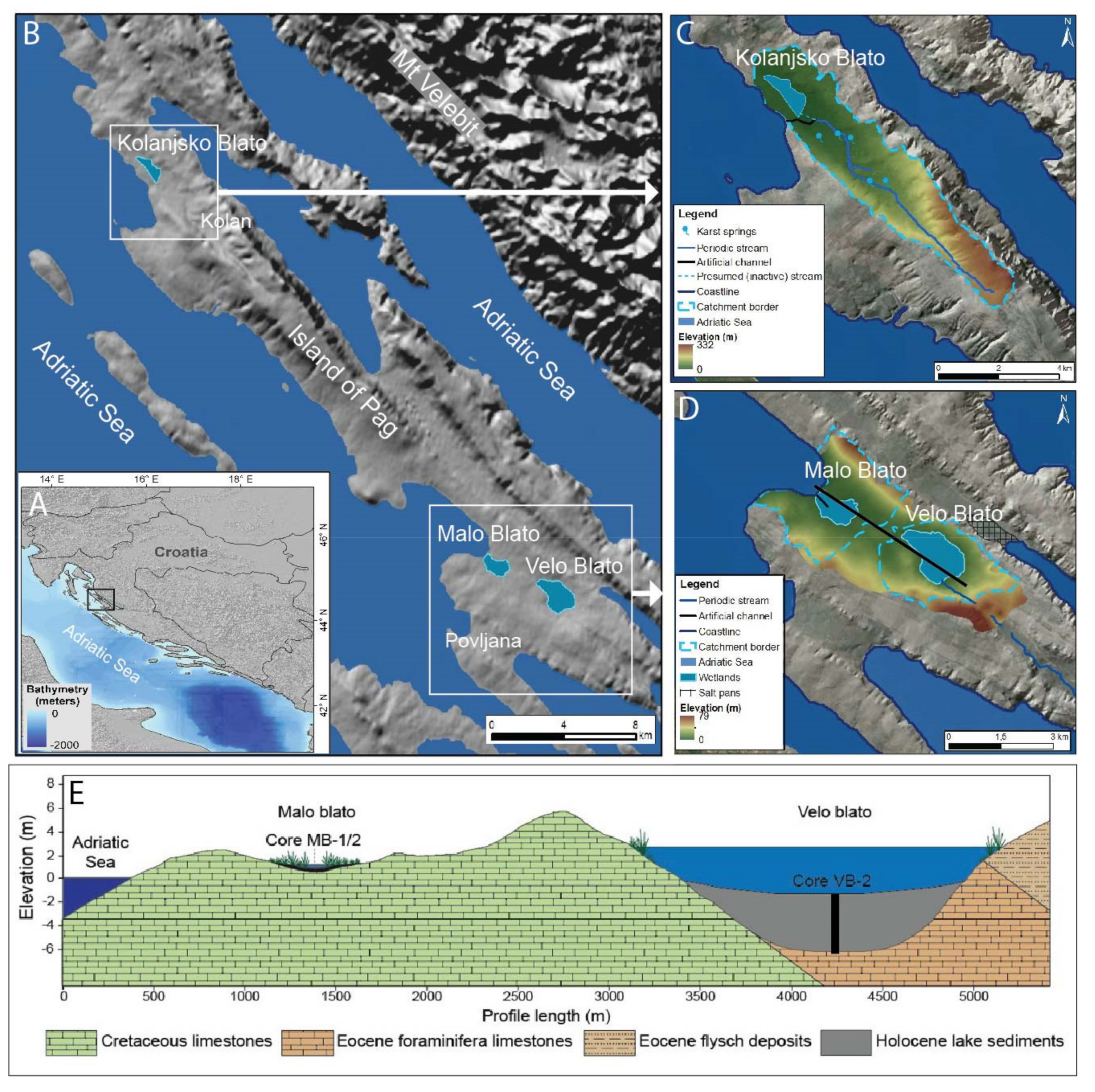
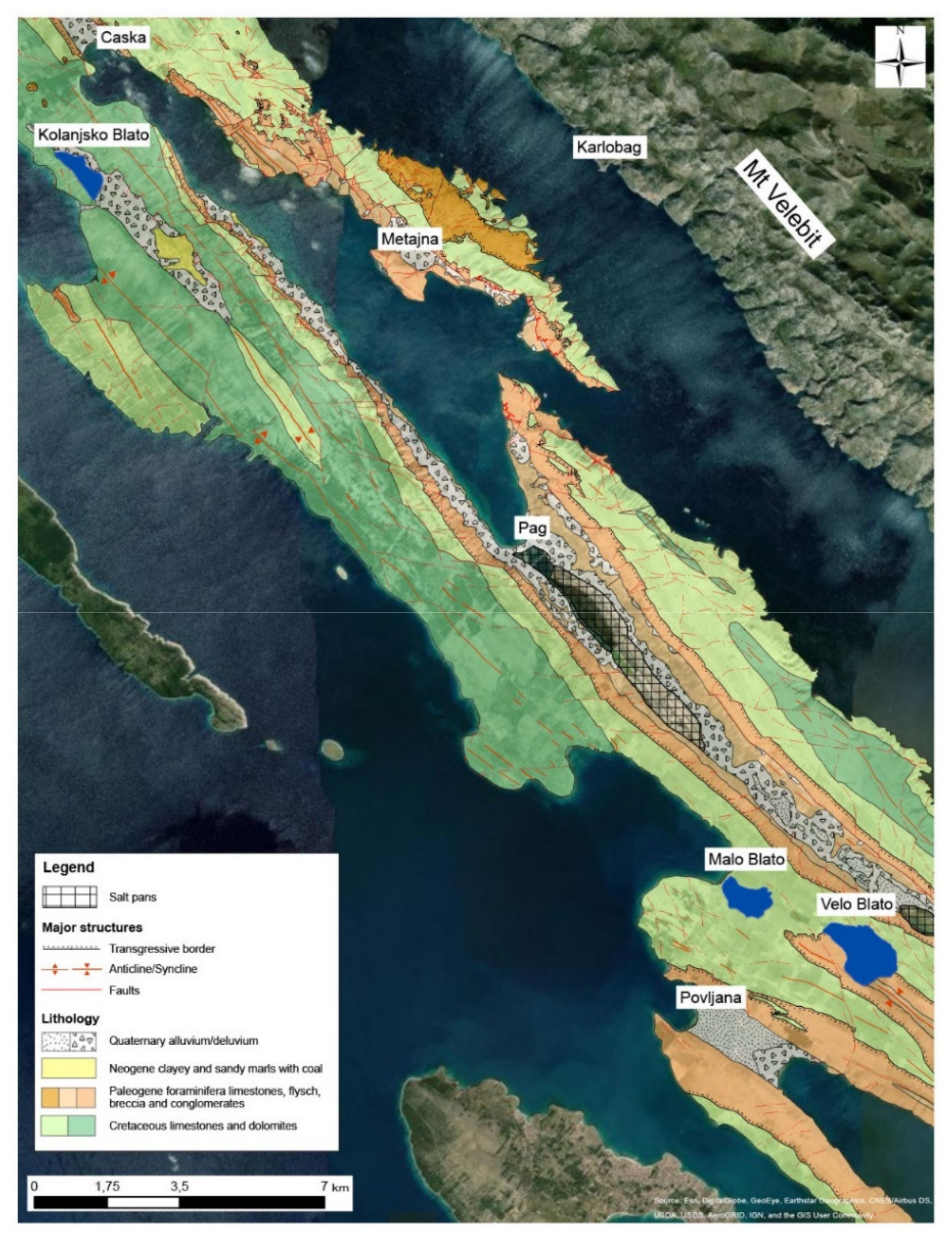
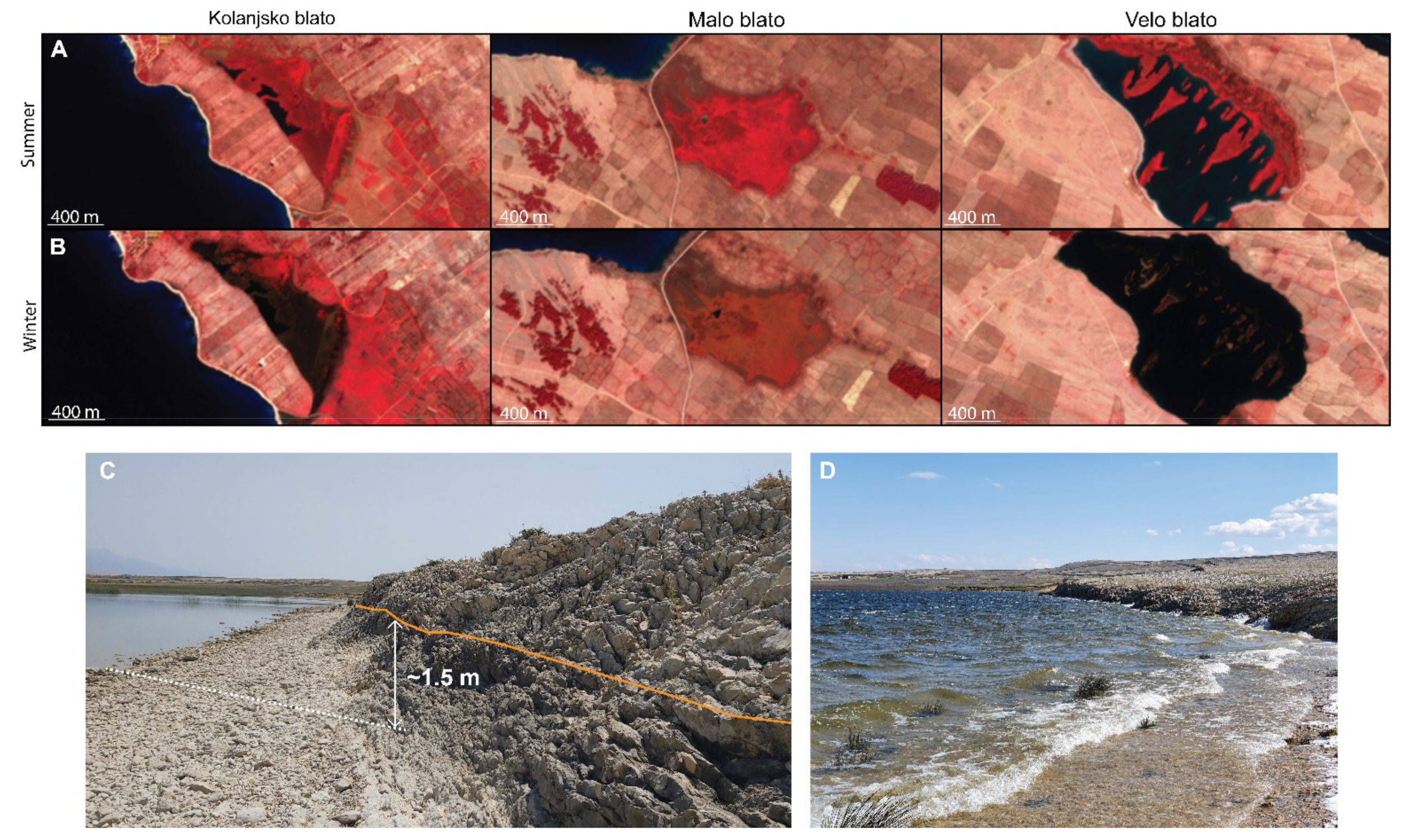
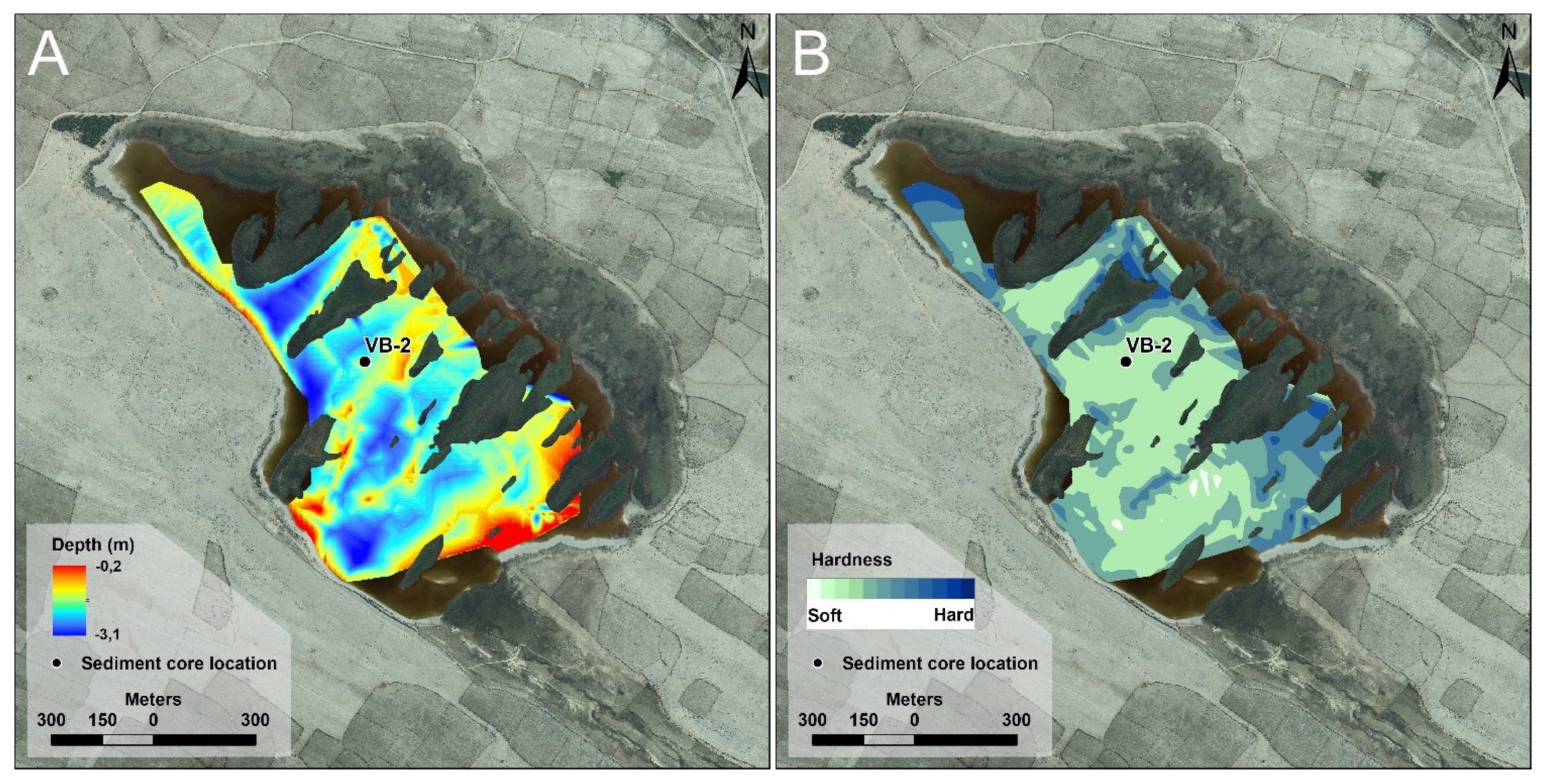
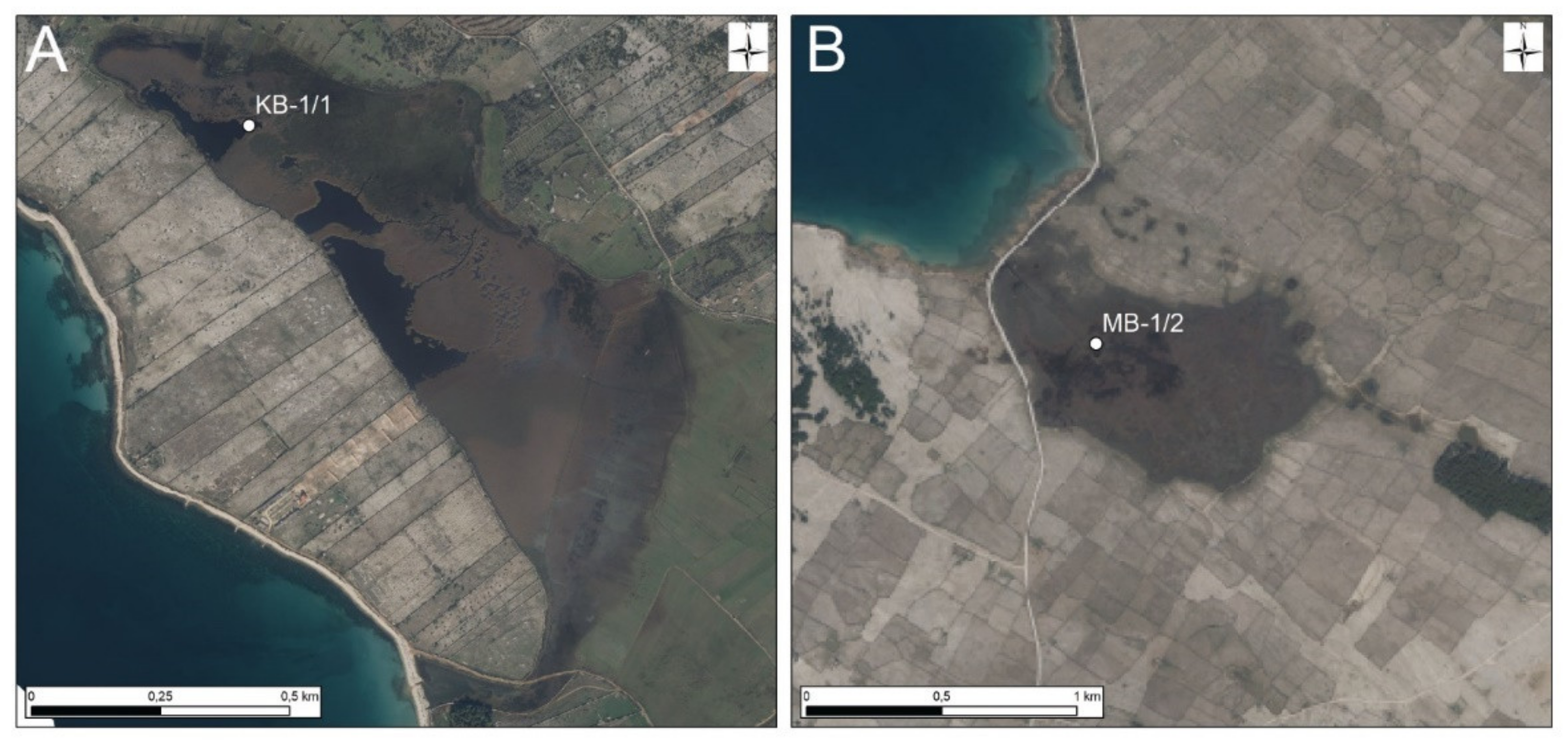
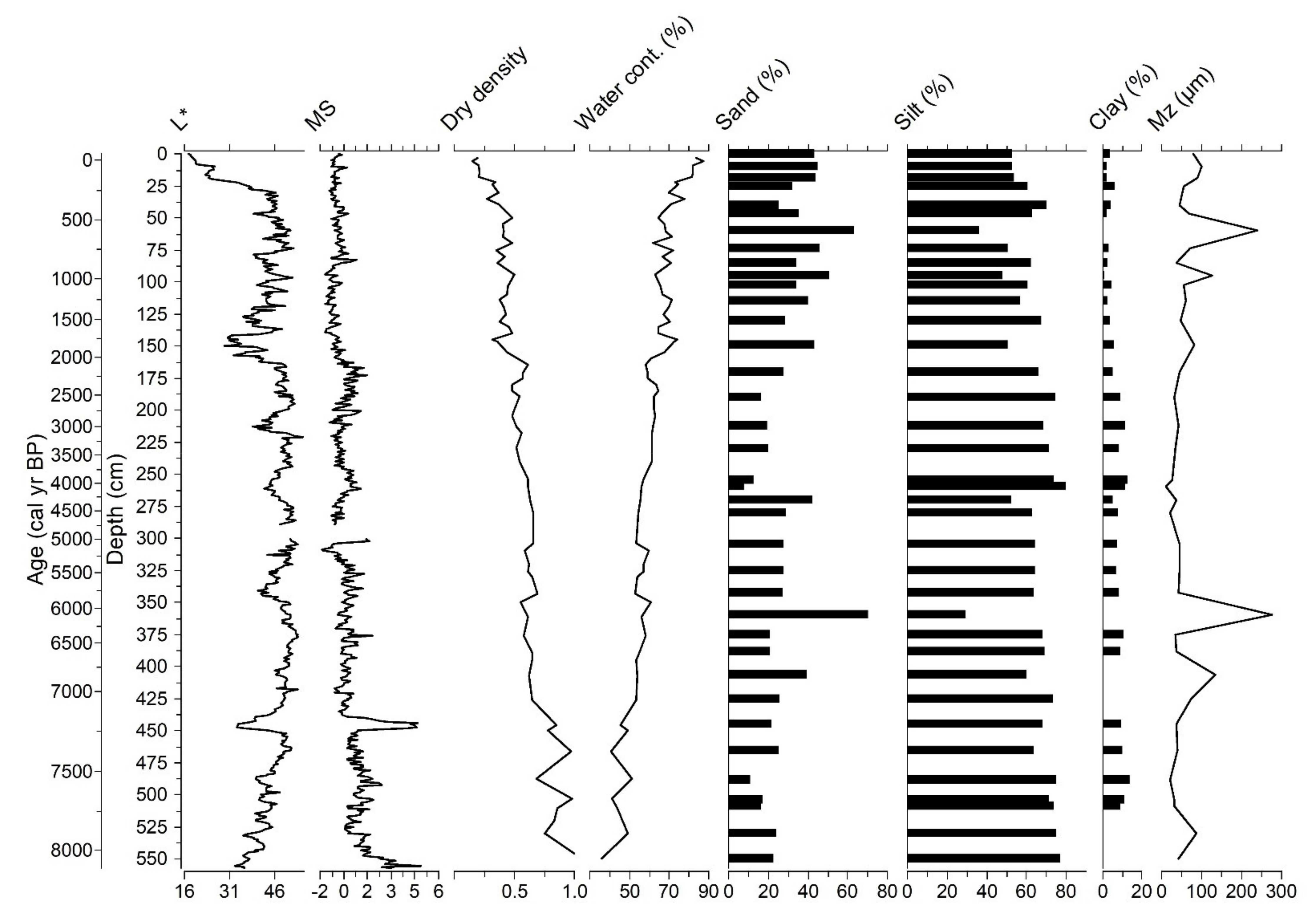

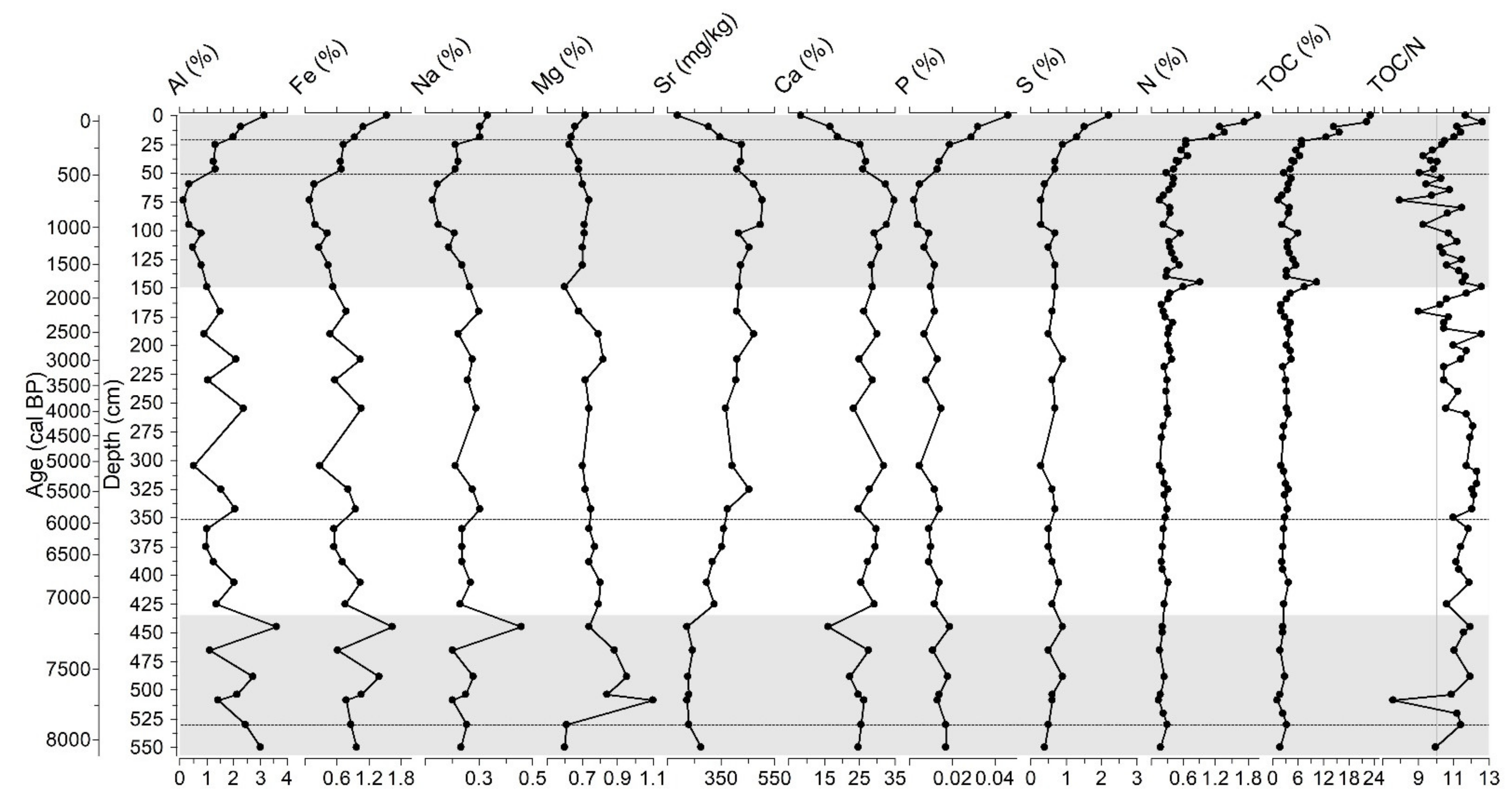
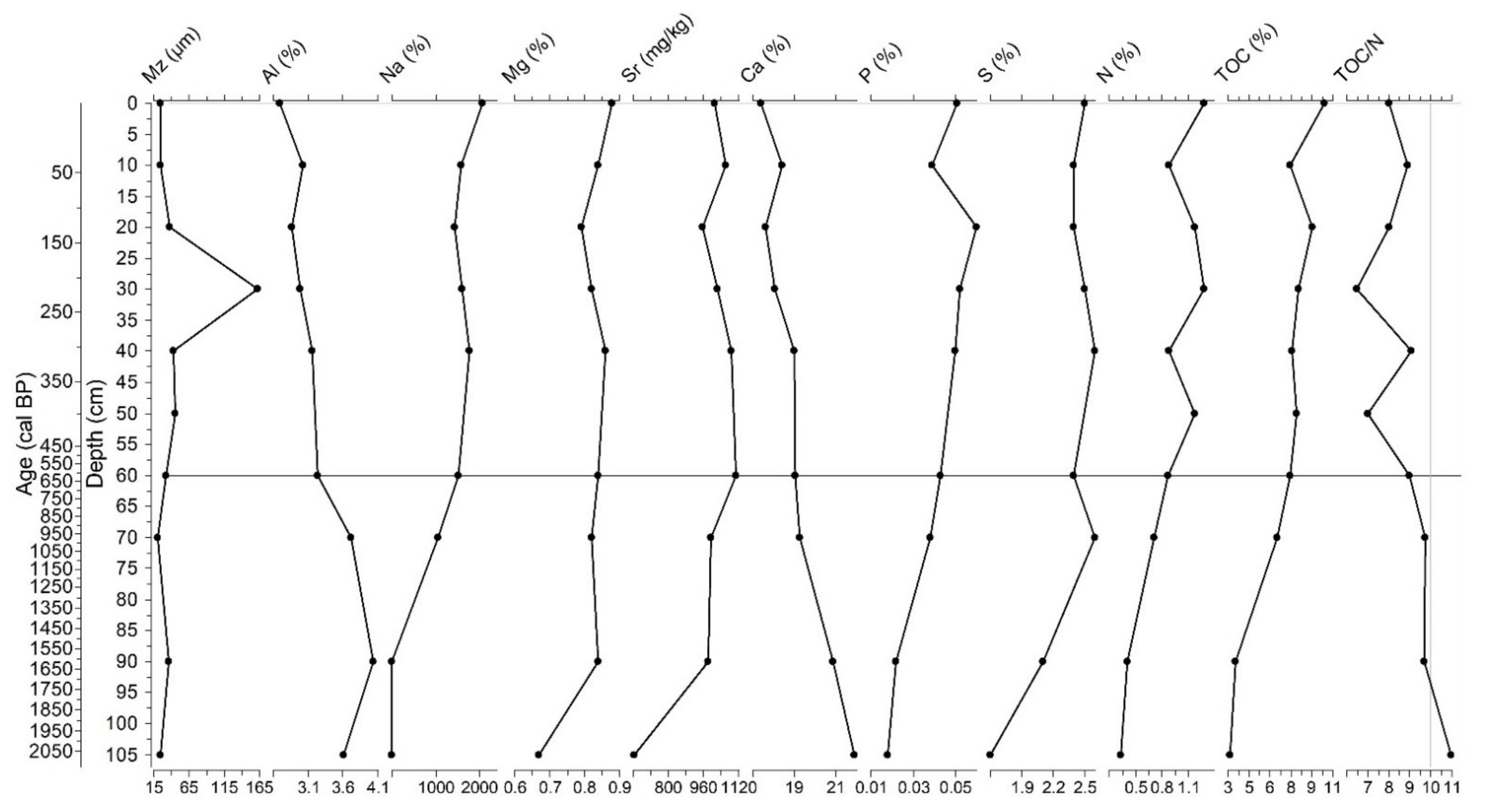
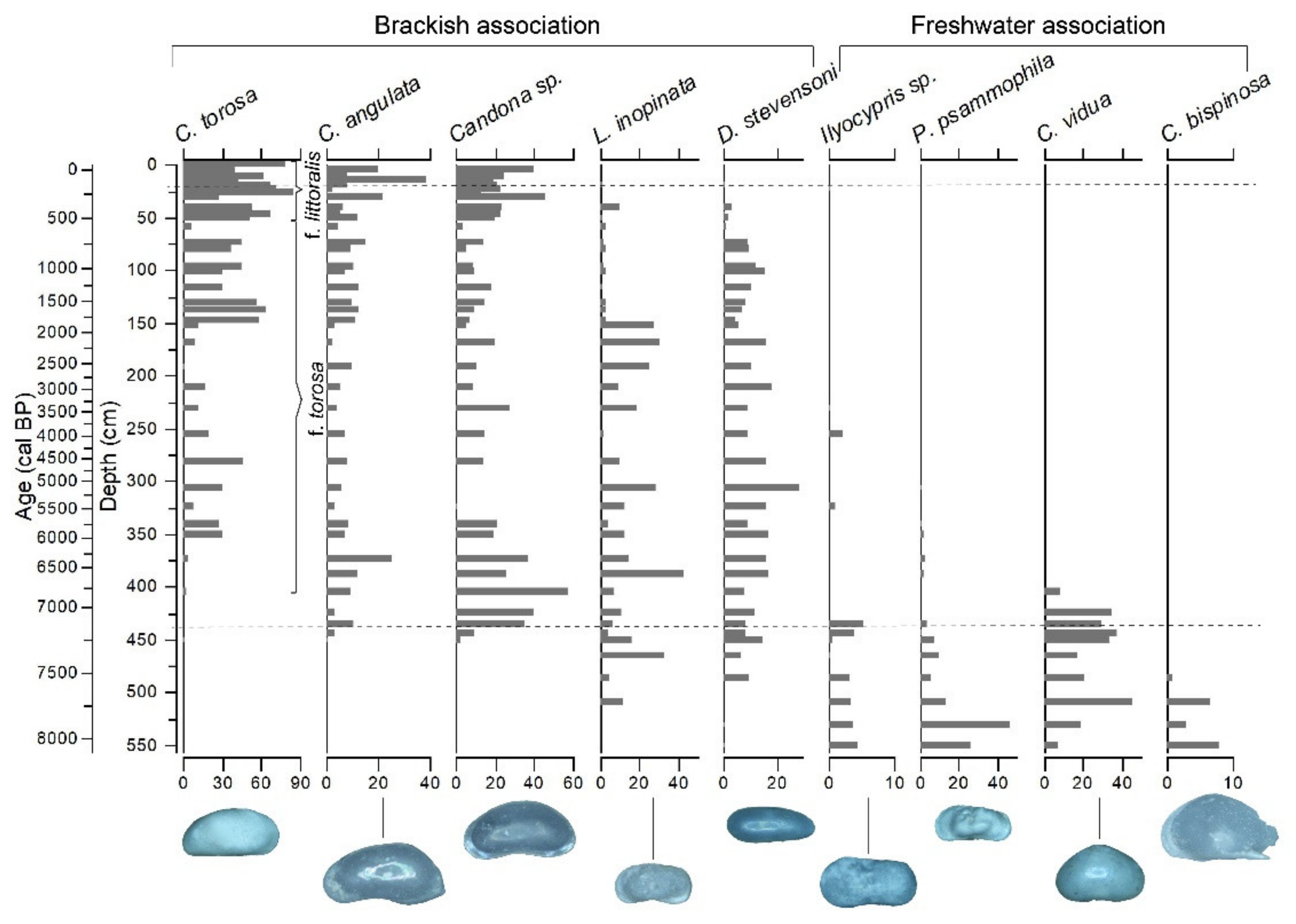
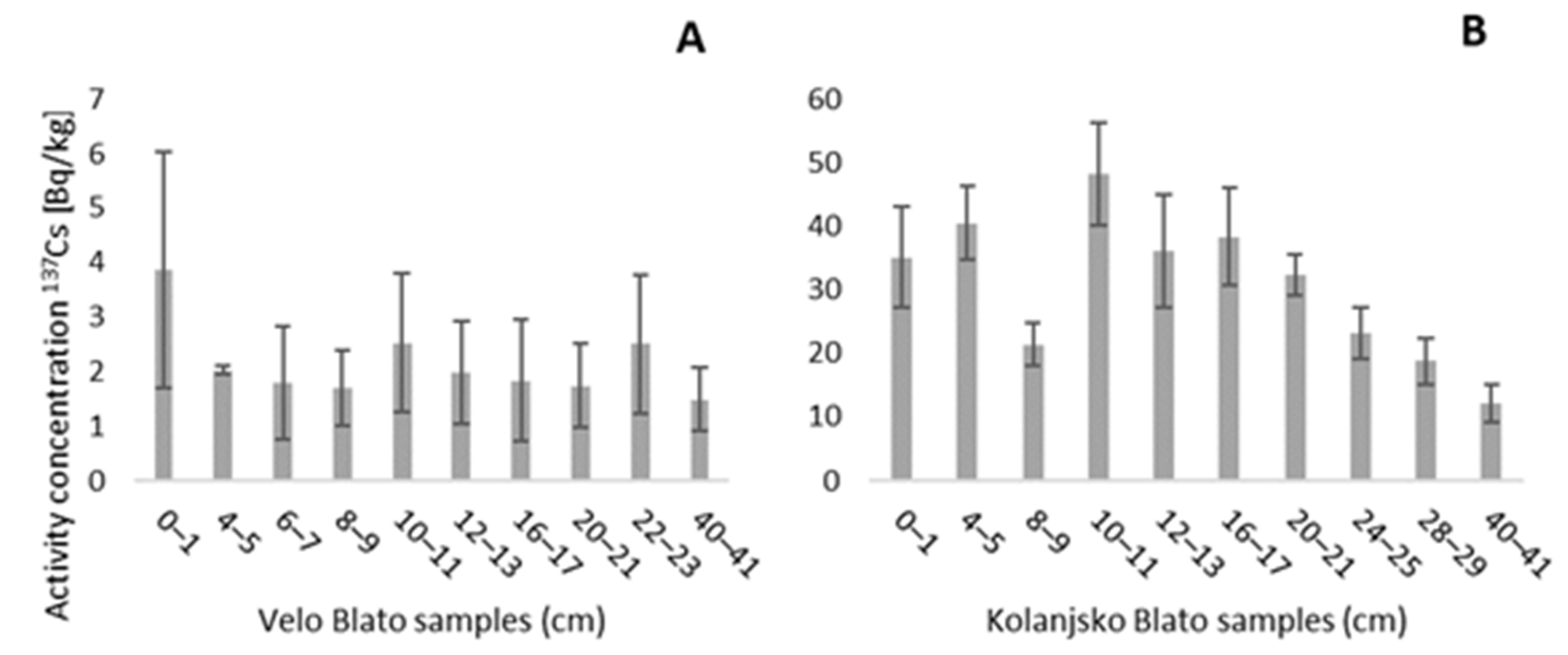
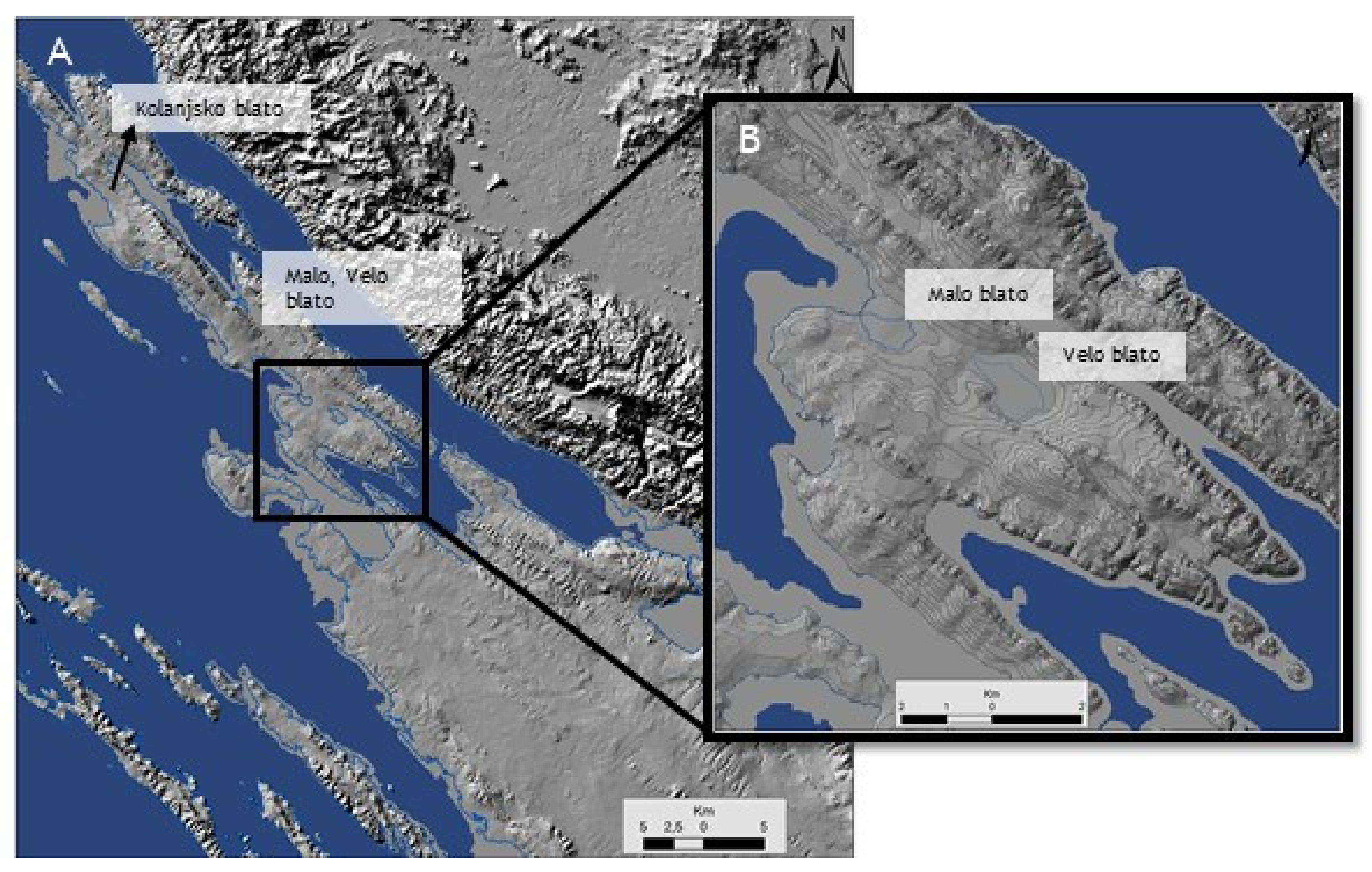
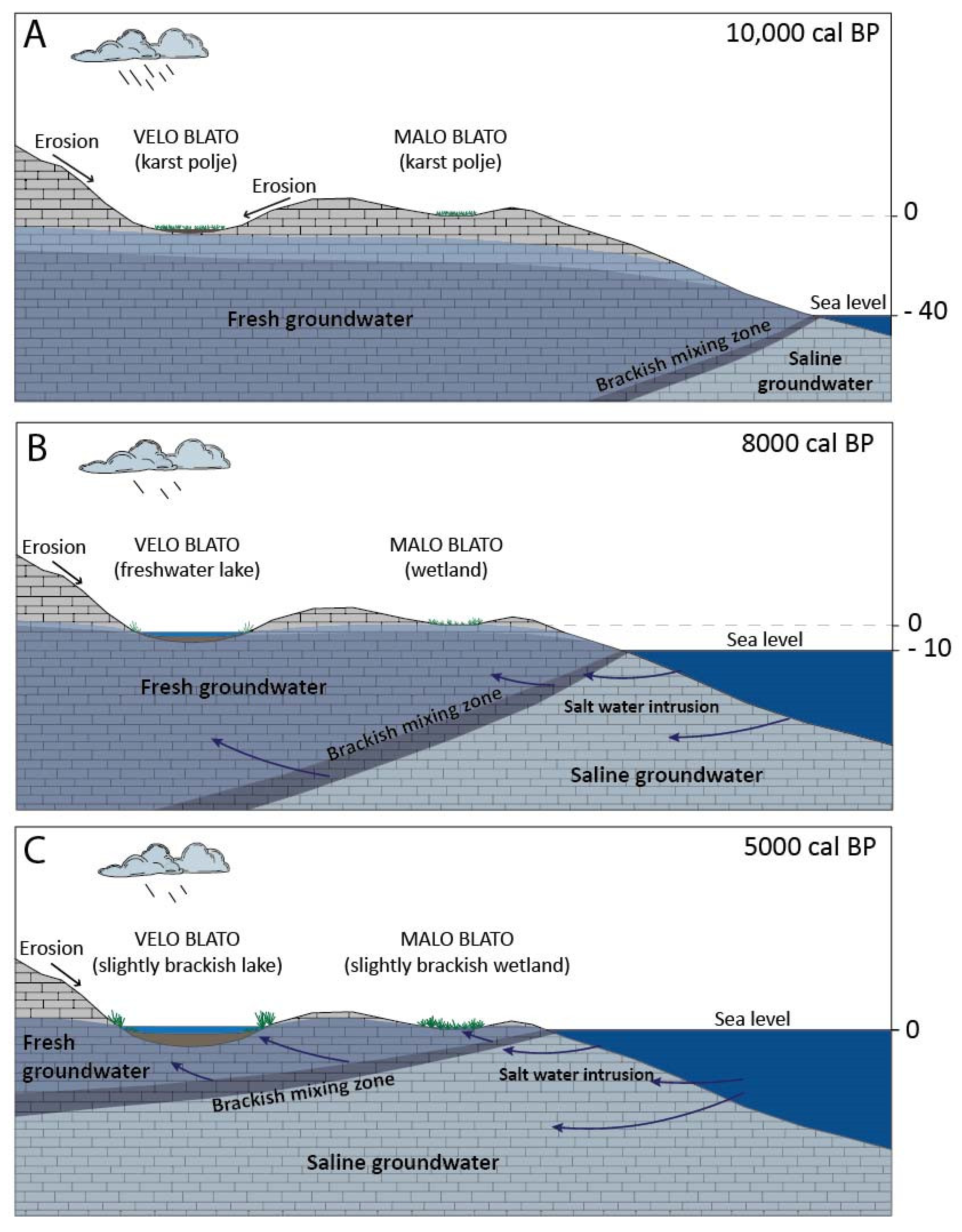
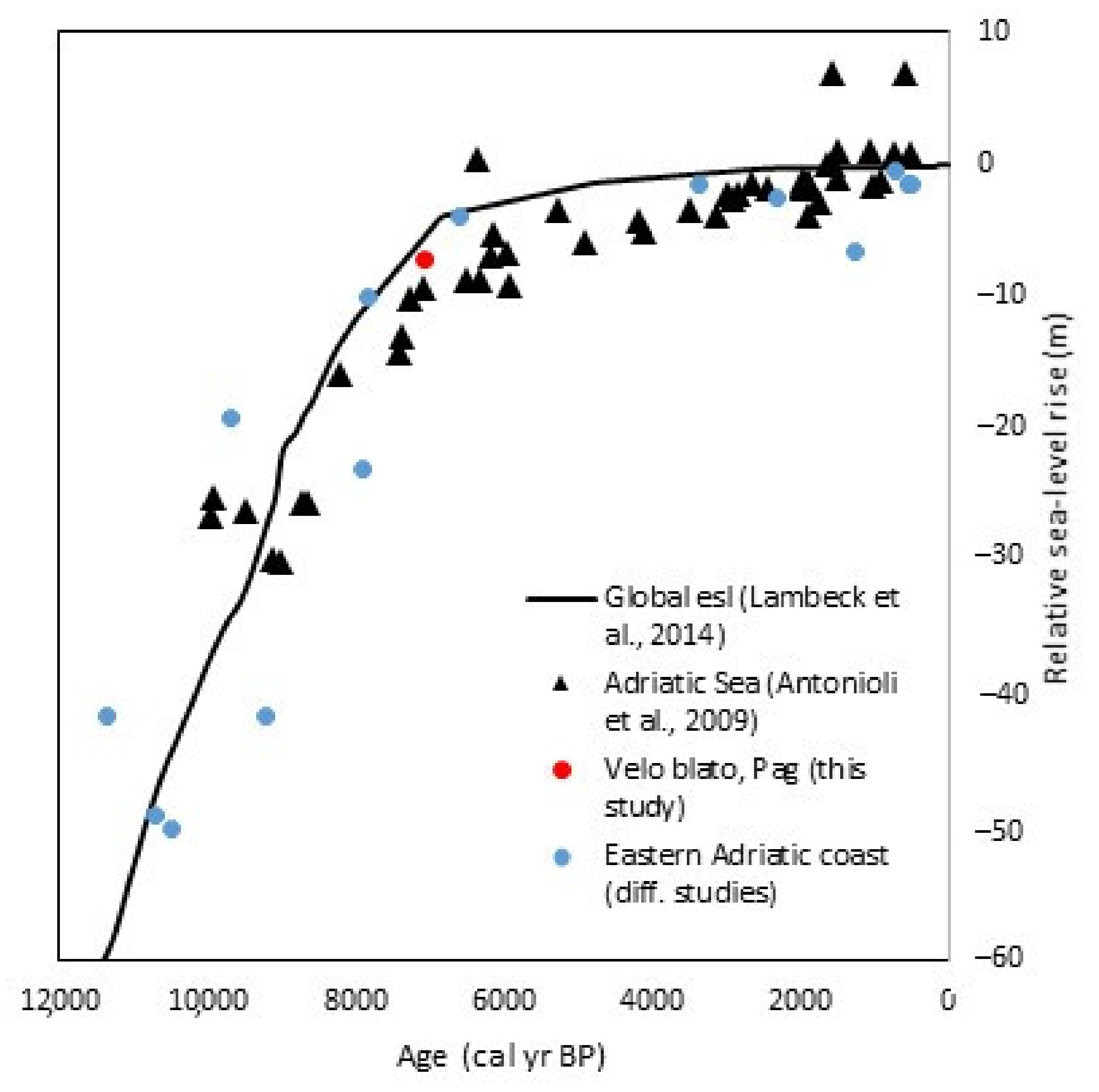
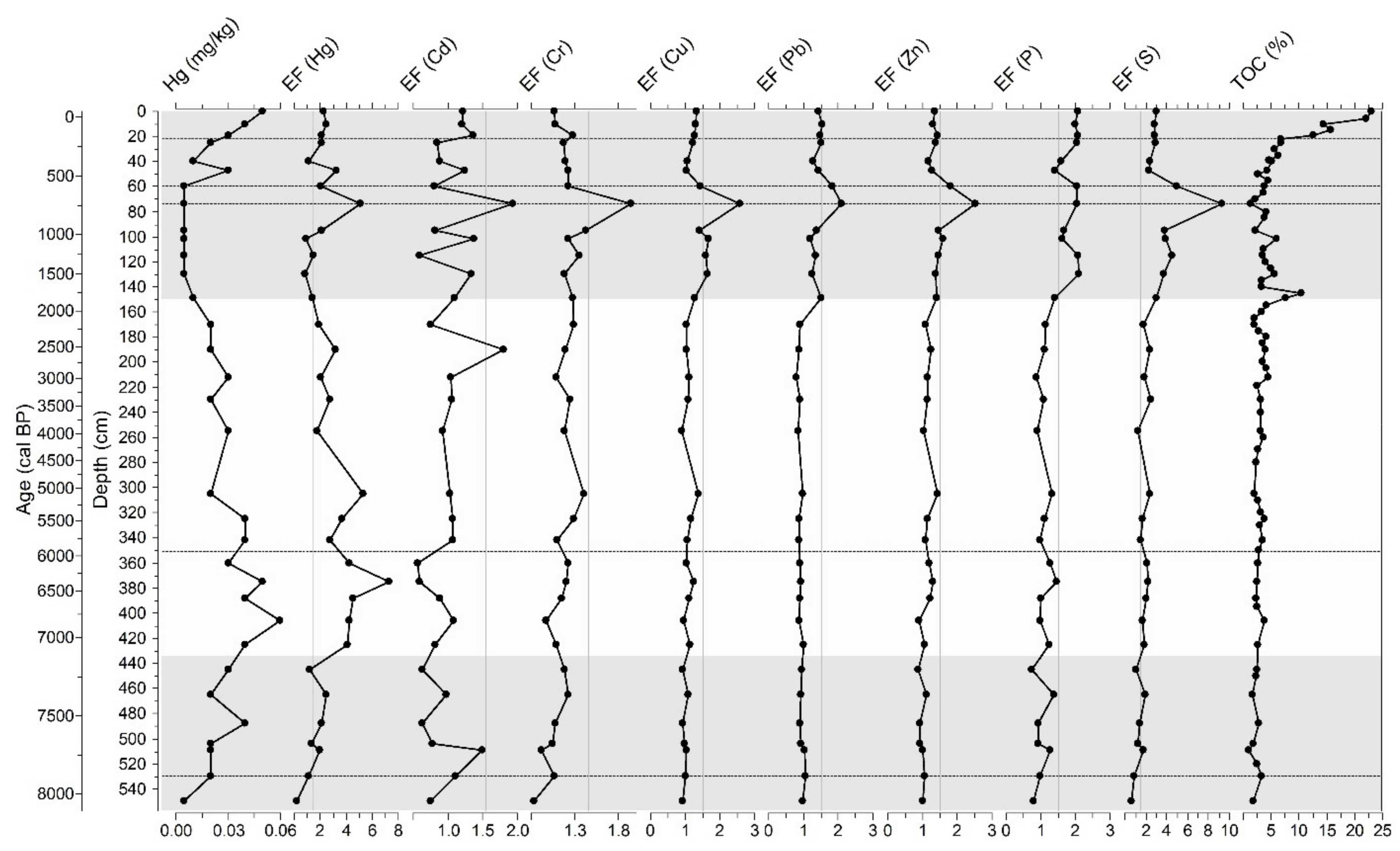
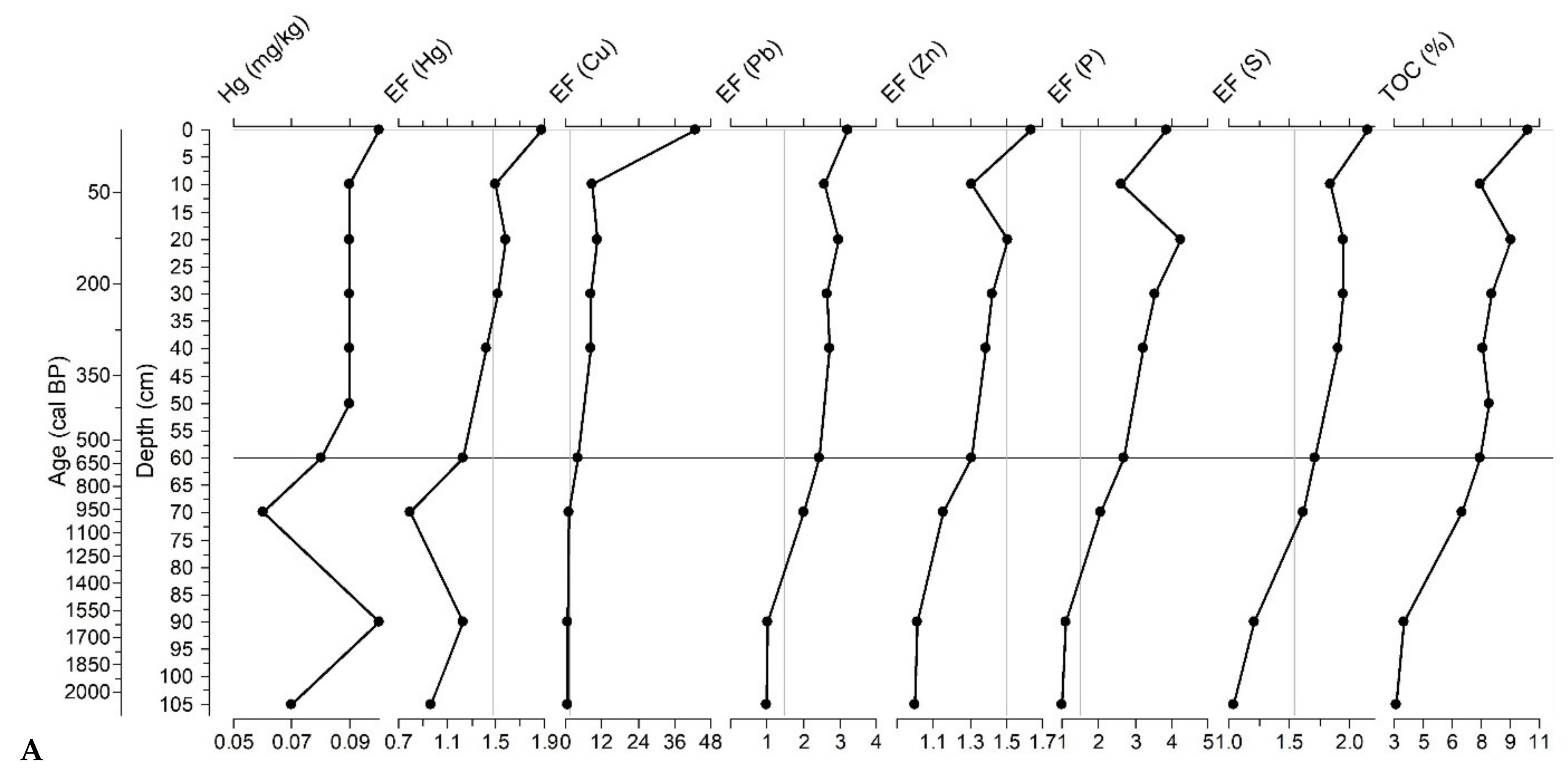
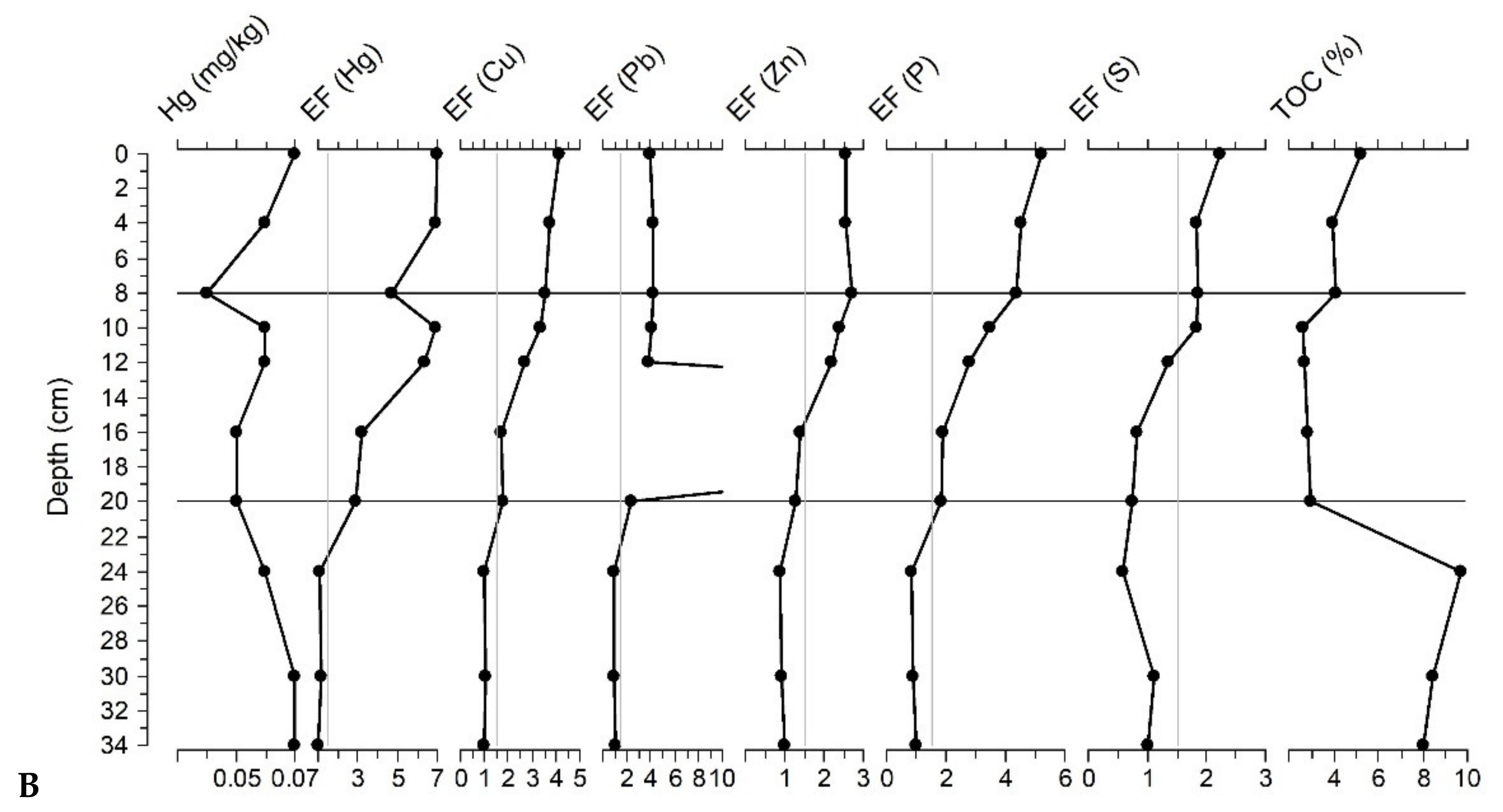
| Water Sample | VB Water Pumping Station (Winter) | VB Water Pumping Station (Summer) | VB-1 (NW Part) | VB-2 (E Part) | MB-1 | KB-1 (W Part) | KB-2 (Central Part) | KB-3 (E Part) |
|---|---|---|---|---|---|---|---|---|
| T (°C) | 14.2 | 21.1 | 10.1 | 11.2 | 9 | 7.9 | 8.9 | 9.3 |
| pH | 7.4 | 7.7 | 8.32 | 8.5 | 7.8 | 8.11 | 8.18 | 8.26 |
| O2 (mg/L) | 4.3 | 6.6 | 11.6 | 13.4 | 11 | 10.8 | 11.6 | 11.9 |
| EC (mS/cm) | 1.75 | 2.27 | 2.08 | 2.09 | 3.8 | 4.88 | 9.8 | 9.55 |
| Cl− (mg/L) | 404.7 | 617.2 | 996.6 | 1000.1 | 1898.1 | 2700.8 | 6257.9 | 6042.3 |
| NO2− (mg/L) | 0.31 | <0.009 | <0.01 | 0.31 | <0.01 | <0.01 | <0.01 | <0.01 |
| NO3− (mg/L) | 0.45 | 0.45 | 0.37 | 0.39 | 0.7 | <0.1 | <0.1 | <0.1 |
| SO42− (mg/L) | 85.4 | 91.8 | 92.2 | 90.7 | 176.4 | 216.6 | 584.8 | 569.7 |
| NH4+ (mg/L) | 0.1 | 0.4 | 0.06 | 0.04 | 0.01 | 0.04 | <0.01 | <0.01 |
| Ca2+ (mg/L) | n.a. * | n.a. * | 82.5 | 82.1 | 108.1 | 114 | 145.1 | 138.1 |
| Mg2+ (mg/L) | n.a. * | n.a. * | 30.6 | 30.8 | 53.9 | 77.2 | 166.8 | 161.7 |
| Na+ (mg/L) | n.a. * | n.a. * | 575.1 | 575.9 | 1118.6 | 1618.4 | 3604.7 | 3554.3 |
| K+ (mg/L) | n.a. * | n.a. * | 9.1 | 9.2 | 17.0 | 23.9 | 57.9 | 56.2 |
| HCO3− (mg/L) | n.a. * | n.a. * | 250 | 250 | 280 | 360 | 380 | 370 |
| TN (mg/L) | 0.002 | 0.0024 | n.a. * | n.a. * | n.a. * | n.a. * | n.a. * | n.a. * |
| TP (mg/L) | 0.0058 | 0.0082 | n.a. * | n.a. * | n.a. * | n.a. * | n.a. * | n.a. * |
| Lab ID | Sample (cm) | Material | δ13C (‰) | δ18O (‰) | pMC | Conventional 14C Age | Calendar Age (2σ Calibration) |
|---|---|---|---|---|---|---|---|
| Beta-591017 | KB-1/1 55–56 | Shell (marine) | −5.7 | +1.5 | 95.26 ± 0.36 | 390 ± 30 BP | 560-Post BP cal BP |
| Beta-591018 | KB-1/1 77–78 | Shell (marine) | −5.3 | +0.3 | 85.27 ± 0.32 | 1280 ± 30 BP | 1468–316 cal BP |
| Beta-591019 | KB-1/1 106–107 | Shell (marine) | −9.7 | −0.2 | 76.80 ± 0.29 | 2120 ± 30 BP | 2491–1110 cal BP |
| Beta-591020 | VB-2 105–106 | Shell (freshwater) | −3.1 | −0.2 | 85.7 ± 0.32 | 1240 ± 30 BP | 1192–1070 cal BP |
| Beta-591021 | VB-2 105–106 | Plant | −25.8 | 86.55 ± 0.32 | 1160 ± 30 BP | 1130–972 cal BP | |
| Beta-591022 | VB-2 201–202 | Shell (freshwater) | +0.1 | −1.5 | 71.54 ± 0.27 | 2690 ± 30 BP | 2851–2752 cal BP |
| Beta-591023 | VB-2 308–309 | Shell (freshwater) | −1.2 | −2.2 | 55.71 ± 0.21 | 4700 ± 30 BP | 5423–5321 cal BP |
| Beta-591024 | VB-2 308–309 | Plant | −25.8 | 57.04 ± 0.21 | 4510 ± 30 BP | 5202–5048 cal BP | |
| Beta-591025 | VB-2 402–403 | Shell (freshwater) | +2.9 | −2.0 | 46.10 ± 0.17 | 6220 ± 30 BP | 7134–7003 cal BP |
| Beta-591026 | VB-2 552–554 | Shell (freshwater) | −5.8 | −1.9 | 39.56 ± 0.15 | 7450 ± 30 BP | 8346–8187 cal BP |
| Element | Velo Blato Sediment Core (VB-2) | Malo Blato Sediment Core (MB-1/2) | Kolanjsko Blato Sed. Core (KB-1/1) | ||||||||||||
|---|---|---|---|---|---|---|---|---|---|---|---|---|---|---|---|
| Min | Max | Mean | Med. | SD | Min | Max | Mean | Med. | SD | Min | Max | Mean | Med. | SD | |
| Al (%) | 0.14 | 3.63 | 1.53 | 1.33 | 0.86 | 0.57 | 4.66 | 1.75 | 0.86 | 1.57 | 2.64 | 3.99 | 3.21 | 3.11 | 0.42 |
| Ba (mg/kg) | 44 | 165 | 79 | 74 | 25 | 37 | 160 | 73 | 47 | 47 | 75 | 114 | 91 | 89 | 11 |
| Ca (%) | 8.42 | 34.75 | 26.17 | 26.77 | 5.14 | 6.77 | 27.22 | 20.40 | 24.64 | 7.91 | 17.38 | 21.85 | 19.05 | 18.97 | 1.39 |
| Cd (mg/kg) | 0.1 | 0.7 | 0.3 | 0.2 | 0.2 | 0.4 | 0.9 | 0.6 | 0.6 | 0.2 | 0.4 | 0.7 | 0.5 | 0.5 | 0.1 |
| Co (mg/kg) | 0.6 | 7.9 | 3.7 | 3.1 | 1.9 | 0.7 | 8.4 | 3.0 | 1.3 | 3.0 | 8.1 | 11.9 | 9.2 | 8.7 | 1.2 |
| Cr (mg/kg) | 5 | 80 | 32 | 28 | 16 | 12 | 74 | 30 | 16 | 25 | 43 | 66 | 52 | 51 | 7 |
| Cu (mg/kg) | 1.5 | 17.6 | 7.1 | 6.3 | 3.6 | 4.7 | 12.8 | 7.4 | 5.8 | 2.8 | 13.5 | 429.2 | 104.4 | 94.2 | 121.1 |
| Fe (%) | 0.09 | 1.64 | 0.75 | 0.72 | 0.37 | 0.22 | 2.43 | 0.77 | 0.28 | 0.84 | 1.94 | 2.51 | 2.20 | 2.16 | 0.15 |
| Hg (mg/kg) | 0.01 | 0.06 | 0.02 | 0.02 | 0.02 | 0.04 | 0.07 | 0.06 | 0.06 | 0.01 | 0.06 | 0.10 | 0.09 | 0.09 | 0.01 |
| K (%) | 0.04 | 0.92 | 0.39 | 0.35 | 0.20 | 0.16 | 1.09 | 0.43 | 0.23 | 0.35 | 0.48 | 0.75 | 0.57 | 0.57 | 0.08 |
| La (mg/kg) | 1.8 | 21.8 | 8.7 | 7.3 | 4.6 | 4.4 | 25.8 | 10.9 | 6.4 | 8.0 | 13.3 | 24.4 | 18.0 | 17.7 | 3.6 |
| Mg (%) | 0.60 | 1.10 | 0.74 | 0.72 | 0.10 | 0.57 | 0.72 | 0.65 | 0.65 | 0.05 | 0.67 | 0.88 | 0.82 | 0.84 | 0.06 |
| Mn (mg/kg) | 121 | 325 | 236 | 242 | 49 | 63 | 129 | 89 | 87 | 20 | 481 | 748 | 652 | 660 | 68 |
| Mo (mg/kg) | 0.10 | 1.00 | 0.44 | 0.40 | 0.17 | 0.30 | 1.90 | 0.68 | 0.55 | 0.46 | 1.40 | 3.40 | 2.09 | 2 | 0.52 |
| Na (%) | 0.128 | 0.457 | 0.247 | 0.238 | 0.059 | 0.491 | 0.814 | 0.608 | 0.555 | 0.114 | 0.639 | 2.073 | 1.371 | 1.519 | 0.461 |
| Ni (mg/kg) | 1.3 | 42.9 | 18.6 | 17.0 | 9.8 | 3.4 | 40.2 | 14.2 | 6.7 | 13.8 | 31.5 | 43.8 | 38.2 | 39.4 | 3.7 |
| P (%) | 0.002 | 0.046 | 0.014 | 0.012 | 0.008 | 0014 | 0.037 | 0.022 | 0.021 | 0.007 | 0.018 | 0.060 | 0.041 | 0.043 | 0.013 |
| Pb (mg/kg) | 1.0 | 15.4 | 5.7 | 5.1 | 3.3 | 9.7 | 313.0 | 42.3 | 10.9 | 90.3 | 12.6 | 30.2 | 25.1 | 27.5 | 6.3 |
| Rb (mg/kg) | 2.00 | 58.90 | 24.83 | 22.10 | 13.86 | 8 | 69.80 | 25.73 | 12.20 | 23.52 | 30.80 | 55.30 | 39.56 | 36.90 | 7.83 |
| S (%) | 0.3 | 2.2 | 0.7 | 0.6 | 0.4 | 0.4 | 2.2 | 0.9 | 0.5 | 0.7 | 1.6 | 2.6 | 2.3 | 2.4 | 0.3 |
| Sr (mg/kg) | 188 | 504 | 360 | 373 | 89 | 127 | 389 | 305 | 365 | 106 | 643 | 1107 | 985 | 1012 | 130 |
| Ti (%) | 0.008 | 0.208 | 0.081 | 0.072 | 0.044 | 0.034 | 0.243 | 0.094 | 0.052 | 0.078 | 0.114 | 0.182 | 0.140 | 0.136 | 0.022 |
| V (mg/kg) | 3 | 55 | 27 | 24 | 14 | 8 | 71 | 25 | 11 | 24 | 28 | 58 | 39 | 35 | 10 |
| Zn (mg/kg) | 5 | 61 | 25 | 22 | 12 | 18 | 60 | 29 | 20 | 15 | 52 | 63 | 60 | 61 | 3 |
| Zr (mg/kg) | 1.8 | 42.7 | 18.0 | 16.3 | 9.8 | 6.7 | 56.7 | 21.2 | 10.8 | 19.0 | 30.7 | 48.5 | 37.4 | 36.9 | 6.1 |
Publisher’s Note: MDPI stays neutral with regard to jurisdictional claims in published maps and institutional affiliations. |
© 2022 by the authors. Licensee MDPI, Basel, Switzerland. This article is an open access article distributed under the terms and conditions of the Creative Commons Attribution (CC BY) license (https://creativecommons.org/licenses/by/4.0/).
Share and Cite
Ilijanić, N.; Miko, S.; Ivkić Filipović, I.; Hasan, O.; Šparica Miko, M.; Petrinec, B.; Terzić, J.; Marković, T. A Holocene Sedimentary Record and the Impact of Sea-Level Rise in the Karst Lake Velo Blato and the Wetlands on Pag Island (Croatia). Water 2022, 14, 342. https://doi.org/10.3390/w14030342
Ilijanić N, Miko S, Ivkić Filipović I, Hasan O, Šparica Miko M, Petrinec B, Terzić J, Marković T. A Holocene Sedimentary Record and the Impact of Sea-Level Rise in the Karst Lake Velo Blato and the Wetlands on Pag Island (Croatia). Water. 2022; 14(3):342. https://doi.org/10.3390/w14030342
Chicago/Turabian StyleIlijanić, Nikolina, Slobodan Miko, Ivona Ivkić Filipović, Ozren Hasan, Martina Šparica Miko, Branko Petrinec, Josip Terzić, and Tamara Marković. 2022. "A Holocene Sedimentary Record and the Impact of Sea-Level Rise in the Karst Lake Velo Blato and the Wetlands on Pag Island (Croatia)" Water 14, no. 3: 342. https://doi.org/10.3390/w14030342
APA StyleIlijanić, N., Miko, S., Ivkić Filipović, I., Hasan, O., Šparica Miko, M., Petrinec, B., Terzić, J., & Marković, T. (2022). A Holocene Sedimentary Record and the Impact of Sea-Level Rise in the Karst Lake Velo Blato and the Wetlands on Pag Island (Croatia). Water, 14(3), 342. https://doi.org/10.3390/w14030342










